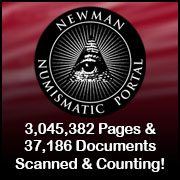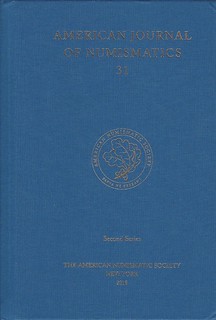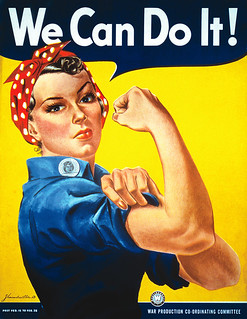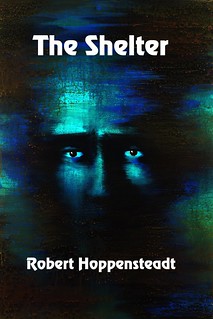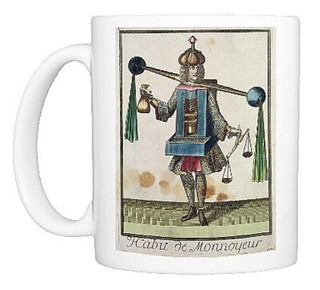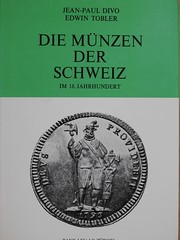
About UsThe Numismatic Bibliomania Society is a non-profit association devoted to the study and enjoyment of numismatic literature. For more information please see our web site at coinbooks.org SubscriptionsThose wishing to become new E-Sylum subscribers (or wishing to Unsubscribe) can go to the following web page link MembershipThere is a membership application available on the web site Membership Application To join, print the application and return it with your check to the address printed on the application. Print/Digital membership is $40 to addresses in the U.S., and $60 elsewhere. A digital-only membership is available for $25. For those without web access, write to: Charles Heck, Treasurer
AsylumFor Asylum mailing address changes and other membership questions, contact Chuck at this email address: treasurer@coinbooks.org SubmissionsTo submit items for publication in The E-Sylum, write to the Editor at this address: whomren@gmail.com BUY THE BOOK BEFORE THE COINSale CalendarWatch here for updates! |
- WAYNE'S WORDS: THE E-SYLUM APRIL 1, 2020
- NEW BOOK: THE MEDIEVAL COINS OF WÜRZBURG
- NEW BOOK: PLEASE IGNORE OUR TIME MACHINE
- PERIODICAL: AMERICAN JOURNAL OF NUMISMATICS 31
- DWIGHT L. MUSSER (1926-2018)
- DAVID E. SEELYE (1946-2020)
- DANIEL "TINY" CROSS (1960-2020)
- 1883 CENTS-LESS LIBERTY NICKEL CRITIQUE
- JOIN NATIONAL ARCHIVES TRANSCRIPTION INITIATIVE
- 2020 NEWMAN GRANT PROGRAM DEADLINE APRIL 1
- VIDEO: BLAST WHITE AND TONED MORGAN DOLLARS
- YELLOW FEVER AT THE U.S. MINT
- ROYAL MINT RETOOLS TO MAKE MEDICAL VISORS
- PERSPECTIVES ON THE POGUE VII SALE
- CORONAVIRUS UPDATES: MARCH 29, 2020
- BUYERS FLOCK TO BULLION AND COINS
- HOBBIES ALL-IMPORTANT DURING CRISIS
- MORE ON EARLIEST USE OF THE WORD 'NUMISMATICS'
- NOTES FROM E-SYLUM READERS: MARCH 29, 2020
- QUERY: VAIL MEDAL BROOCH
- MORE ON THE MINTER'S COSTUME
- NUMISMATIST EDITOR BARBARA GREGORY RETIRING
- NGC CERTIFIES 10,000,000 SILVER EAGLES
- U.S. MINT AUTOMATES SLABBING WITH PARTNERSHIP
- MUDLARKING AND METAL DETECTING FINDS
- VOCABULARY TERM: KEY TAG MEDAL
- DR. RICHARD GEORGE DOTY (1942-2013)
- HARVEY STACK'S NUMISMATIC FAMILY, PART 66
- A NUMISMATIST'S VISIT TO NEW ORLEANS
- MORE SELECTIONS FROM DAVISSON'S AUCTION 39
- ARCHIVES INTERNATIONAL SALE #58 SELECTIONS
- THE UNION LEAGUE MEDAL OF HONOR
- SECURITY MARBLING ON FINANCIAL INSTRUMENTS
- VIDEO: JAPANESE BANKNOTE SECURITY FEATURES
- LOOSE CHANGE: MARCH 29, 2020
- PULL TAB ARCHEOLOGY
- COLLECTING BANANA LABELS
- FEATURED WEB SITE: MALTA NUMISMATIC SOCIETY
Click here to access the complete archive
To comment or submit articles, reply to whomren@gmail.com
Content presented in The E-Sylum is not necessarily researched or independently fact-checked, and views expressed do not necessarily represent those of the Numismatic Bibliomania Society.
WAYNE'S WORDS: THE E-SYLUM APRIL 1, 2020
 This week we open with two new books, a periodical, three obituaries, updates from the Newman Numismatic Portal, and stories about the Yellow Fever and the U.S.
Mint.
This week we open with two new books, a periodical, three obituaries, updates from the Newman Numismatic Portal, and stories about the Yellow Fever and the U.S.
Mint.
Other topics this week include the 1883 "No Cents" nickel, perspectives on the coin market, coronavirus updates, the Minter's Costume, U.S. Mint automation, third-party graders, key tag medals, auction selections, security marbling, the Bermanian Guild of Numismatists and the Malta Numismatic Society.
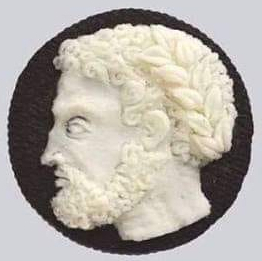 To learn more about the great
snowstorm sale, Isaac Newton's plague-cation, the earliest use of the word "numismatics", Ceylon Agri-Horticultural Show medals, retiring ANA Editor-in-Chief Barbara
Gregory, author Richard Doty, the New Orleans Mint, numismatography, numismaticitis, nummophiles and numismaniacs, the Numismatic Athenaeum and the Royal Bermanian Tickle Token,
read on. Have a great week, everyone!
To learn more about the great
snowstorm sale, Isaac Newton's plague-cation, the earliest use of the word "numismatics", Ceylon Agri-Horticultural Show medals, retiring ANA Editor-in-Chief Barbara
Gregory, author Richard Doty, the New Orleans Mint, numismatography, numismaticitis, nummophiles and numismaniacs, the Numismatic Athenaeum and the Royal Bermanian Tickle Token,
read on. Have a great week, everyone!
Wayne Homren
Editor, The E-Sylum
NEW BOOK: THE MEDIEVAL COINS OF WÜRZBURG
Here is the press release for a new work on the medieval coinage of Würzburg. -Editor
Hubert Ruß publishes standard work on the medieval coinage of Würzburg
Hot off the presses: this new standard work covers medieval coins of the Bishopric of Würzburg. Its author, Dr. Hubert Ruß, is considered one of today's leading experts on Franconian coinage. His book is very important for all numismatists, from researchers, to coin dealers, to collectors.
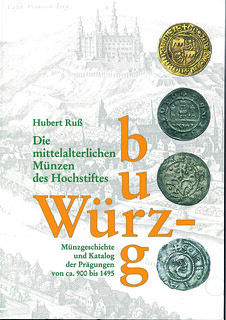 Hubert Ruß, Die mittelalterlichen Münzen
des Hochstiftes Würzburg: Münzgeschichte und Katalog der Prägungen von ca. 900 bis 1495 [“The medieval coins of the Bishopric of Würzburg: monetary history and catalog of coins
from approx. 900 up to 1495”]. Munich 2020. XIV/514 P. with 13 in-text illustrations, 5 diagrams, 14 tables, 1,390 coin illustrations. Hardcover, stitch binding. Size: A4 22 x 30
cm. ISBN 978-3-98137-192-5. Weight: 2,424 g 95 euros
Hubert Ruß, Die mittelalterlichen Münzen
des Hochstiftes Würzburg: Münzgeschichte und Katalog der Prägungen von ca. 900 bis 1495 [“The medieval coins of the Bishopric of Würzburg: monetary history and catalog of coins
from approx. 900 up to 1495”]. Munich 2020. XIV/514 P. with 13 in-text illustrations, 5 diagrams, 14 tables, 1,390 coin illustrations. Hardcover, stitch binding. Size: A4 22 x 30
cm. ISBN 978-3-98137-192-5. Weight: 2,424 g 95 euros
Numismatist Dr. Hubert Ruß has produced a new standard work cataloging the medieval coins of Würzburg (approx. 900-1495). He provides a detailed monetary history of this period, based on a detailed catalog of 699 coin types. His book is an extensive study of the coinage of one of the most important ecclesiastical authorities in southern Germany. It is also an essential reference work for anybody that is working with or researching the coinage of Würzburg.
The Diocese of Würzburg
Bonifatius is said to have founded the diocese of Würzburg around the year 741/2. He chose a strategically favorable place for the seat of this bishopric located on the river
Main. At a time when there weren't any usable roads in Central Europe, the Main connected the wealthy Bohemia to the hubs of trade and crafts located on the Rhine. This means that
Würzburg gained a very high level of political and economic significance. And, for that reason, coins were being minted there from as far back as the Early Middle Ages: the first
coins were issued in the name of King Louis the Child (899-911). The first written reference to the minting privilege of the Würzburg bishops dates back to 1030. At that time, the
bishops had already been using the mint for a long time, together with the kings and emperors of the Holy Roman Empire. This practice ended with Henry IV, Holy Roman Emperor.
Since Bishop Erlung (1006-1121), coins in Würzburg were minted almost exclusively by bishops.
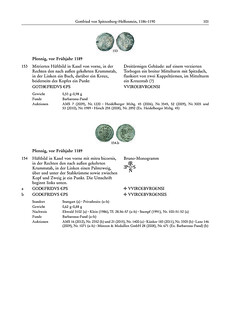
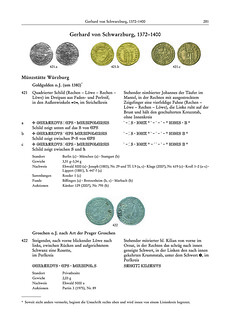
New research findings
Hubert Ruß's standard work presents a monetary history of the Bishopric, based on state-of- the-art research. It contains a wide range of new insights, which are greatly
significant for numismatics:
- A range of unpublished coin types and varieties
- A range of previously unknown mints, mint masters, and denominations
- New datings and new attributions of a range of coin types to bishops or rulers
- Record of mint masters and other mint officials mentioned in archival sources
- Two of the mint masters among the Catholic bishops were Jewish
- Record of all European hoards with Würzburg coins, up to 2018
- Evaluation of the archival sources for the Würzburg coin standard, weight and fineness
An easy-to-use reference work
Hubert Ruß has produced a type catalog, describing many never-before published coin types for the first time. Every coin type is cataloged in full with all varieties; the text
also provides locations of coins at coin cabinets, auction catalogues, and numismatic literature. Thanks to the multiple concordances, monogram concordance, and extensive
register, the catalog and texts are quick and easy to explore, even for impatient users. The book is priced at 95 euros and is available to buy from
Künker Numismatik AG
Löwengrube 12
D-80333 Munich
Tel.: +49 89 5527849 0
service@kuenker-numismatik.de
or from
Fritz Rudolf Künker
Nobbenburger Str. 4a
D-49076 Osnabrück
Tel.: +49 541 96 202 0
service@kuenker.de
NEW BOOK: PLEASE IGNORE OUR TIME MACHINE
The cover of the Central States Numismatic Society's "magazine that never was" featured that lovable 19th century San Francisco eccentric "Norton I, Emperor of the United States and Protector of Mexico". Today's equivalent in modern numismatics in dealer Allen Berman and his alter ego King Alanus of Bermania. This press release announces a new book published by the Royal Bermanian Printing Office. -Editor
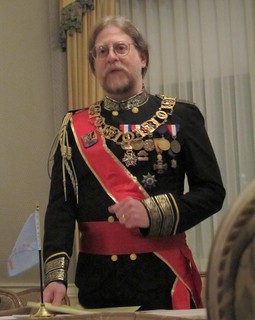 Many readers have
heard of the jovial Bermanian Guild of Numismatists over the years. Led by King Alanus of Bermania (aka Numismatist Allen G. Berman), this organization has been meeting to hear
humorous short stories at the New York International Numismatic Convention and other major events since the 1990s. Unfortunately, auction schedules have prevented many from
attending at times. Finally, the Royal Bermanian Printing Office, in collaboration with Amazon.com, has enabled all who need a laugh to enjoy these stories on their own
schedule.
Many readers have
heard of the jovial Bermanian Guild of Numismatists over the years. Led by King Alanus of Bermania (aka Numismatist Allen G. Berman), this organization has been meeting to hear
humorous short stories at the New York International Numismatic Convention and other major events since the 1990s. Unfortunately, auction schedules have prevented many from
attending at times. Finally, the Royal Bermanian Printing Office, in collaboration with Amazon.com, has enabled all who need a laugh to enjoy these stories on their own
schedule.
Please Ignore Our Time Machine: Exciting Tales of Da Vinci, Pastrami, Time Travel, and Howard Hughes is set in a quaint little Eastern European kingdom, filled with nice but idiosyncratic people and peppered with dragons and cynical, talking horses. The story traces the escapades of the Bermanian people as they creatively navigate the globe and the centuries. It also gives the origins of some important Bermanian coin issues, such as the Royal Bermanian Tickle Token.
According to Red Book editor emeritus and former ANA President Kenneth Bressett, “I surely do find it fascinating. It warms my heart to know there are still people in this world that think the way he does, and can share their enthusiasm with others. His sense of humor, knowledge of all things historical, fictional, and utopian is astounding. … It will take a prominent place in the ‘treasured' section of my library.”
Observing the current situation, where most people around the globe are forced to stay at home and are spending more time pursuing indoor activities, Bressett commented, “I truly enjoyed the book and I am sure that others will too. It is a great remedy for these weeks of confinement and isolation. Even those not of Bermanian persuasion will find it a most intriguing adventure through time.”
The 310 page book is available both in soft cover and Kindle versions. The soft cover, autographed, is available directly from Allen G. Berman (POB 605, Fairfield, CT 06824; agberman@aol.com) for $15 plus $4 postage. However King Alanus has authorized Amazon.com to provide the book at a discounted price of $13.95. The eBook is available exclusively through Amazon.com ($5.95) as His Majesty does not know how to use an eBook. Other Bermanian products available at the Royal Bermanian Website, http://www.bermania.org/
Here's the book's full description from Amazon. -Editor
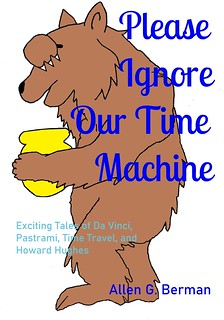 Please Ignore Our
Time Machine is set in a quirky little Eastern European kingdom, filled with nice but idiosyncratic people and peppered with dragons and cynical, talking horses. The story
traces the escapades of the Bermanian people as they creatively navigate the globe and the centuries.
Please Ignore Our
Time Machine is set in a quirky little Eastern European kingdom, filled with nice but idiosyncratic people and peppered with dragons and cynical, talking horses. The story
traces the escapades of the Bermanian people as they creatively navigate the globe and the centuries.
Melvin the Octogenarian has just uprooted his ancient people from their ancestral home in Brooklyn. Following his hunch that the mysterious “Tourist Brochure,” will lead them to a land flowing with milk and honey, they arrive at the Bering Sea with few provisions. So what's to worry? Howard Hughes' Spruce Goose pulls up before them, and the motley crowd of peasants and livestock file onto the plane, arguing about any triviality they can think of all the while. Such is the sort of preposterous turn of events which brings laughter to those who follow this quirky tribe to their new home near the Danube. . . . Zerbi just created an anesthetic based on boredom, while his assistant mistakes his other invention, a time machine, for a device to reincarnate latkes. Some scientists are more perceptive than others, but they are Bermanians all!
An interwoven series of stories, some would say they have a bit of the flavors of Sholem Aleichem and Terry Pratchett. Excerpts have been pleasing audiences at micro-national gatherings (http://www.bermania.org/) and professional conferences for decades. Now it's time to let the rest of the world in on the joke.
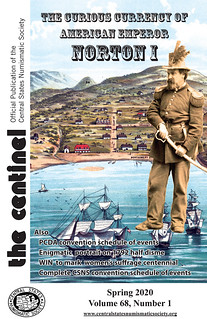 For more information on the
book, or to order, see:
For more information on the
book, or to order, see:
Please Ignore Our Time Machine: Exciting Tales of Da Vinci, Pastrami, Time Travel,
and Howard Hughes (https://www.amazon.com/Please-Ignore-Our-Time-Machine-ebook/dp/B084FMFBK7/ref=sr_1_1)
For more information on the Kingdom of Bermania, see:
http://www.bermania.org/
For more on the "magazine that never was", see:
PERIODICAL: THE CENTINEL SPRING 2020 (https://www.coinbooks.org/v23/esylum_v23n12a08.html)
PERIODICAL: AMERICAN JOURNAL OF NUMISMATICS 31
The American Numismatic Society has published the latest volume of the American Journal of Numismatics (AJN). At my request editor David Yoon kindly forwarded the table of contents for AJN 31 and excerpts of two articles of interest to students of U.S. medals and colonial currency (appearing elsewhere in this issue). Thanks! -Editor
• Errata to AJN 29 vii
• Charlotte Potts. Made in Etruria: Recontextualizing the Ramo Secco 1
• Lloyd W. H. Taylor. Birds of Feather, Brothers in Arms: The Coinage of Andragoras and Sophytes 21
• Zahra Alinezhad, Arthur Houghton, and Mostafa Dehpahlavan. New Light on Uncertain Mint 65 81
• Eric Carlen. The Spearhead and Monogram Coinage of Ptolemy V 95
• Dominic Machado. The Distribution and Circulation of the Victoriatus in Northern Italy 117
• Martin Beckmann. The Gold Coinage of Hadrian, AD 130–138 143
• David Woods. Gallienus, Amalthea, and the Pietas Faleri 187
• Qi Xiaoyan. Samarqand's Cast Coinage from the Early Seventh to the Mid-Eighth Century AD: An Assessment Based on Chinese Sources and Numismatic Evidence 205
• Jeremy A. Simmons. Making Sense of Nonsense: Approaches to Greco-Roman Legends on Western K?atrapa Coinage 225
• Jake Benson. Curious Colors of Currency: Security Marbling on Financial Instruments During the Long Eighteenth Century 277
• Frank Kovacs. The Medal of Honor of the Union League of Philadelphia
For more information on the American Journal of Numismatics, see:
http://numismatics.org/publications/ajn/

DWIGHT L. MUSSER (1926-2018)
Neil Shafer writes:
"Just recently I found out that this great pioneer in the paper money field had passed away in mid-2018 at the age of 92. Older collectors may remember his high profile activity in his first love, the emergency notes of Germany from the post-World War I period, generally referred to as Notgeld. He was a true master of the field, with his years of the highest activity in the 1960s and 1970s. He delved into every conceivable aspect of these colorful little pieces, publishing a wide variety of pamphlets and articles on the subject.
In his later years he lived in West Virginia and steadily decreased his numismatic activity. Glaucoma put a virtual end to his work with notes, though he was in communication with a number of folks by phone. He was also given some well-deserved recognition by the IBNS through installation into their Hall of Fame. Dwight was a true gentleman who did his best to bring life to this enormous series of notes."
Thanks. Here's an excerpt from Musser's online obituary. -Editor
Dwight L Musser departed this earthly plane to continue the great journey on August 11, 2018.
He is survived by his loving wife of seventy years, Norma Lee (Bradley), four children; David (Janine), Marisa, Cynthia (Stan), Timothy (Sue); five grandchildren; and eight great grandchildren.
Dwight was born on May 10, 1926, in Plymouth, Indiana, during a brief ministerial posting of his father, Rev. J. C. Musser and wife Edna (Phillips), but his roots were deep and forever in the hills of West Virginia. Dwight spent his early years in Glenville and from there to Dunbar where he graduated from High School. He received two undergraduate degrees from Morris Harvey College and his Master of History degree from Marshall University. Dwight, a World War II veteran, served in the US Air Force.
While serving overseas, Dwight became fascinated by the development and myriad manifestations of world-wide forms of currency. His teaching profession transformed into a full-time business selling foreign paper money and he is called, “the Father of World Paper Money Collecting.” He became an expert in the field and contributed many articles to numismatic publications. In 1990, Dwight received the prestigious Numismatic Ambassador Award...
Dwight's primary intellectual pursuits were in American history and religious philosophy with an emphasis on the development of the various expressions of American Christianity as it emerged from the turbulent European experience.
To read Dwight's online obituary, see:
Dwight L. Musser
(https://www.wvnews.com/obituaries/dwight-l-musser/article_0f86a312-a0ac-11e8-8ad5-5b88e573ae66.html)
DAVID E. SEELYE (1946-2020)
Neil Shafer writes:
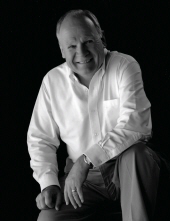 "A wonderful guy and very knowledgeable
numismatist died on March 24. David Seelye was a stalwart in the field of military paper money, tokens, scrip of all sorts, and currency in general. He was a staunch and loyal
supporter of the military currency Fest sponsored by Fred Schwan held annually in Ohio. Always willing to share any and all information with fellow collectors and researchers, he
was also a recent co-author in the field of U.S. prisoner-of-war chits issued in the various camps here in the U.S.
"A wonderful guy and very knowledgeable
numismatist died on March 24. David Seelye was a stalwart in the field of military paper money, tokens, scrip of all sorts, and currency in general. He was a staunch and loyal
supporter of the military currency Fest sponsored by Fred Schwan held annually in Ohio. Always willing to share any and all information with fellow collectors and researchers, he
was also a recent co-author in the field of U.S. prisoner-of-war chits issued in the various camps here in the U.S.
Personally, we went back around 30 or more years, when he was offering notes while he was living in Chili, NY. My first purchase from him was a Bahamas 10 shillings of George V in high grade that I cherished for a long time. All will miss Dave for his friendship and general congeniality which was all-encompassing. Everyone thought very highly of him, and his unique style will be sorely missed."
Jeffrey Zarit of Wylie, Texas writes:
"I first knew David while he lived in Chili, New York in the early 1970's. He was always an easy going person. Later he worked for a colleague Robert Westfall from Marietta, Ohio. We were often in contact, buying and selling world coins. Even after he started with Military Currency, we did some business. A few years ago, he contacted me about some coins that he accumulated, and I bought them all. Every so often he was offered some coins and he contacted me. I guess I have not physically seen him in about 20 years, but in my mind, I remembered him as always being fair in his business life. We were friends & colleagues for more than 45 years and the world and I miss him greatly."
Bill Myers writes:
"David was the Military Payment Certificate fester who had an inventory worthy of a museum and the knowledge to go with it. He was always willing to take the time to share his knowledge and I am a better numismatist because of it. After David moved to Prescott he was only a few hours away from me so we communicated and saw each other more and become friends as well as colleagues. His contributions to numismatics will be his legacy but his friendship will keep his memory alive. Rest in peace good friend."
In the MPC Gram Series 21 No. 2403 (Mar 27, 2020) Fred Schwan writes:
"In the short time since we received word of David Seelye's passing, I have been reflecting on memories of David. The thing that stands out to me is the enthusiasm that he brought to our little, out-of-the-way hobby. He came to the community because somewhere, somehow he found a copy of the chart that reports the number of MPC replacements that are reported for each issue.
"He was a long time dealer in world coins. When he saw this chart, he was immediately attracted to the scarcity of even the most common replacement when compared to many coins that are considered to be scarce or rare. He was excited and jumped into the market. More or less simultaneously started dealing in regular issues.
"He bought, bought, and bought. Some collectors thought that he was reckless. Some collectors approached me wanting me to control him! That was an opportunity for a little lecture on the free market system.
"I think that David did pay too much for some replacements. He also found some really great replacements that had evaded discovery for decades! He found the first Series 591 50 cent replacement, the first 100 A yen replacement and some others. It was truly remarkable.
"Immediately upon joining the community he became a tireless backer. One after another David discovered areas within the military numismatics community that were new to him. Prisoner of war chits, propaganda notes and others became specialties. He approached all of these new areas with the enthusiasm that he had brought to MPC replacements. It was fund to watch the excitement that he displayed in pursuing these areas.
"David put his enthusiasm to work by creating the MPCFest bourse. David recruited dealers for the Fest and led by example. Within just a few years of purchasing his first MPC, David had two full tables at the Fest bourse overflowing with stuff for beginners and advanced collectors."
Thanks, everyone. -Editor
To read David's online obituary, see:
David Eastman Seelye
(https://www.ruffnerwakelin.com/obituaries/David-Eastman-Seelye?obId=12517141)
DANIEL "TINY" CROSS (1960-2020)
Last week David Lange alerted us to the passing of Daniel "Tiny" Cross, "one of the great fixtures of the ANA's Summer Seminar and a really sweet guy who will be missed by all who knew him." -Editor
In the MPC Gram Series 21 No. 2403 (Mar 27, 2020) Fred Schwan writes:
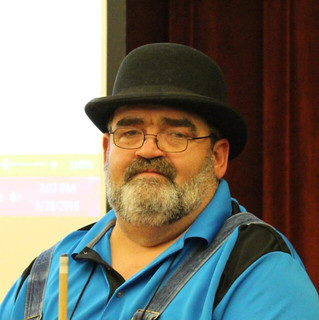 "I considered Tiny to be a good friend.
That was the greatest thing about Tiny. EVERYONE considered themselves to be a good friend of Tiny. He had that way with people.
"I considered Tiny to be a good friend.
That was the greatest thing about Tiny. EVERYONE considered themselves to be a good friend of Tiny. He had that way with people.
"Tiny was a student in a military class. We did not make him into an AMC or MPC collector, but we did make him into a fan. He promoted military numismatics in several ways after taking the class. Tiny collected coin trench art. I am not sure if he collected it before taking the class. Here is what I think happened. He had a few pieces in his token collection. Then when I started beating the trench art coin drum, he jumped into the boat and began to row.
"In any event he was a keen collector of coin trench art. He and I gave a few joint presentations in Colorado on trench art. In those I told everyone that we both had some interesting, historic, and great items. That the difference was that he found his at very low prices while I got mine at high prices. He even had people seek him out and gift the items to him!
"Tiny was a modern hobo nickle carver. A few years ago (well, quite a few years ago now), Tiny gave me a spectacular gift. It was a Fest challenge coin that had been carved! I published the image in the Gram. I cannot find the image or the medal now, but it is a spectacular item, and now a cherished memento.
"At the summer seminar, the administration constantly worries about hydration for the visitors. They provide water in various ways.
"In the military classes, we have a canteen that serves ices sodas! A few people will recall that the canteen is named for Tiny Cross. No one knows why. Since Tiny took the class, he has funded the canteen every year! Obviously we will continue to promote the Tiny Cross Canteen."
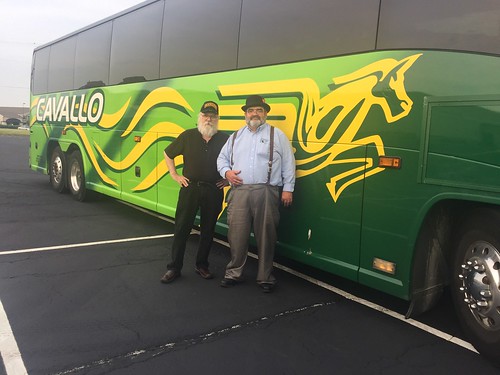
Fred Schwan and Daniel "Tiny" Cross
Peter Huntoon writes:
"I knew Tiny from the American Numismatic Association summer seminars where for the past couple of decades I have been there he maintained a larger than life presence and was one of the best known personalities. His mantra was to be upbeat and helpful. Once he learned your interest, he would find you out days or even years later and present you with some surprise he had found that was right up your alley.
""As one small example, a couple of years ago he found a large bank directory at the ANA book sale that he knew would be my cup of tea, purchased it, lugged it around for a week before I could get there, and handed it to me upon my arrival. This type of generosity was but the tip of the iceberg as he unselfishly and reliably shuttled people about for the two-week duration of those seminars, talked up the various courses, introduced people so they could connect if he knew they shared a common interest, and supported the young numismatics in every way he could.
"His wife was his dear companion and he brought her with him so they both could share and enjoy those times together, and, of course, he was truly devastated when she died.
I prided myself that he had the time to pay a bit of attention to me through all those years and even attend my class and seminars"
John Regitko of Toronto, Canada writes:
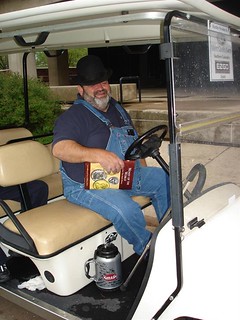 "When I
received a scholarship from the MPCFest to attend the numismatic course at the 2010 ANA Summer Seminar, I was due to have my knees replaced due to acute arthritis. I could not
have traveled between the dormitory, cafeteria building, the building where seminars took place and where other activities took place in the evenings. He came and picked me up
every morning and drove me to the Mess Hall, then to the seminar, to lunch, back to the seminar, for dinner and back to the dormitory. And he did this faithfully for five days. I
could not have walked the distance and could not have done without him. I called him regularly monthly for the next ten years to exchange pleasantries with him. I will never
forget his help, kindness and fun side. I have a photo of him sitting on the golf cart as well as other photos I took of him."
"When I
received a scholarship from the MPCFest to attend the numismatic course at the 2010 ANA Summer Seminar, I was due to have my knees replaced due to acute arthritis. I could not
have traveled between the dormitory, cafeteria building, the building where seminars took place and where other activities took place in the evenings. He came and picked me up
every morning and drove me to the Mess Hall, then to the seminar, to lunch, back to the seminar, for dinner and back to the dormitory. And he did this faithfully for five days. I
could not have walked the distance and could not have done without him. I called him regularly monthly for the next ten years to exchange pleasantries with him. I will never
forget his help, kindness and fun side. I have a photo of him sitting on the golf cart as well as other photos I took of him."
Thanks, everyone. -Editor
To read Tiny's online obituary, see:
Daniel Leo Cross (https://www.butlerfuneralhome.com/obituaries/Daniel-Cross-4/)
To read the earlier E-Sylum article, see:
NOTES FROM E-SYLUM READERS: MARCH 22, 2020 : Daniel "Tiny" Cross (1960-2020)
(https://www.coinbooks.org/v23/esylum_v23n12a16.html)
1883 CENTS-LESS LIBERTY NICKEL CRITIQUE
The latest addition to the Newman Numismatic Portal is a contemporary article about the 1883 "No Cents" Liberty Nickel design. Project Coordinator Len Augsburger provided the following report. -Editor
Granite State Philatelist Disses Liberty Nickel
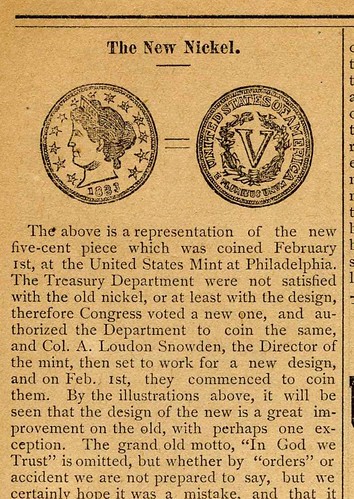 Q. David Bowers recently contributed to Newman Portal a scan of the March, 1883 issue of the Granite State
Philatelist. Philatelic publications, especially from this period, contain occasional numismatic content, and this is a typical example, which includes a few comments regarding
the recently released Liberty nickel.
Q. David Bowers recently contributed to Newman Portal a scan of the March, 1883 issue of the Granite State
Philatelist. Philatelic publications, especially from this period, contain occasional numismatic content, and this is a typical example, which includes a few comments regarding
the recently released Liberty nickel.
While commending the new design, the writer points out the absence of the motto In God We Trust, noting “surely the motto of our forefathers is good enough for us.” The article goes on to discuss the “racketeer” nickel, a creation of “sharpers” who thinly coated 1883 No Cents Liberty nickels with gold and passed them off as five-dollar gold pieces.
The writer suggests that the 1883 No Cents pieces will either be recalled or saved as collector's items, and will no doubt “command a high price” in the future. Quite the opposite happened! So many were saved that today the 1883 With Cents issue is the more highly prized of the two, while the No Cents example is by far the most inexpensive coin in the series in EF-AU grades.
Link to Granite State Philatelist on Newman Portal:
https://nnp.wustl.edu/library/book/580737
JOIN NATIONAL ARCHIVES TRANSCRIPTION INITIATIVE
Roger Burdette invites volunteers to transcribe National Archives documents related to numismatics. Where possible, transcribers will be paired with documents relating to their particular collecting interest. -Editor

The present “virus vacation” offers some free time for several (5 – possibly more) numismatists to transcribe old US Mint documents.
Numismatists currently have little knowledge about the content of most U.S. Mint archive documents. Transcribing handwritten or poorly typed documents it often the only way the content of these materials can be unlocked for use by modern researchers. These will eventually be added to the database maintained by the Newman Numismatic Portal (NNP) at Washington University in St. Louis.
The process is very simple. Transcribers will be sent small groups of documents in PDF format. Read each document and type the text into standard English using MS-Word or a similar word processing program. Follow the instructions for page size, formatting and file naming. When finished, email the completed transcriptions to me and request another batch whenever you're ready for more.
All transcriptions are converted into anonymous documents, then attached to the original archive image.
Here's a typical example - a great letter from Franklin Peale to Treasury Secretary Levi Woodbury. -Editor
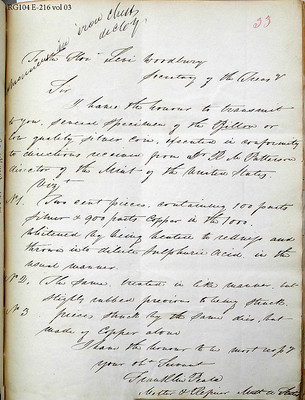 To the Honorable Levi Woodbury
To the Honorable Levi Woodbury
Secretary of the Treasury
Sir
I have the honor to transmit to you, several pieces of the Billion or low quality silver coin, executed in conformity to directions received from R. M. Patterson Director of the Mint of the United States. Viz:
No 1. Two cent pieces, containing 100 parts silver & 900 parts copper in the 1000. Whitened by being heated to redness and thrown into dilute Sulphuric [sic] acid in the usual manner.
No 2. The same, treated in like manner, but slightly rubbed previous to being struck.
No 3. Pieces struck by the same dies, but made of copper alone.
I have the honor to be most respectfully
Your obedient Servant,
Franklin Peale
Melter & Refiner Mint of the United States
To get started and receive a trial set of documents, send your name and email address to me at whomren@gmail.com. I will forward your information to Roger and he will handle everything from there. Thanks! This is a great project that will benefit the hobby for generations to come. -Editor
Link to National Archives & Records Administration (NARA) material on Newman Portal:
https://nnp.wustl.edu/Library/Archives?searchLetter=U
2020 NEWMAN GRANT PROGRAM DEADLINE APRIL 1
Newman Numismatic Portal Project Coordinator Len Augsburger submitted this reminder of the upcoming April 1, 2020 deadline for the 2020 Eric P. Newman Numismatic Education Society (EPNNES) Newman Grant Program. Thanks. -Editor
Eric P. Newman Numismatic Education Society 2020 Newman Grant Program
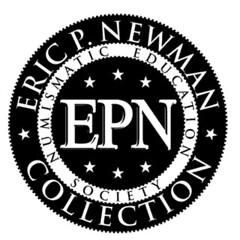 The Eric P. Newman
Numismatic Education Society (EPNNES) solicits grant applications for its 2020 Newman Grant program. EPNNES seeks to make awards that promote original research in American
numismatics, through the sponsorship of travel and related research expenses. Newman Grant awardees for 2019 included Chris McDowell, who created a census of all known Pitt
farthings. Newman Grant awardees allow non-exclusive publication of their research on Newman Numismatic Portal. Applications will be accepted until April 1, 2020, with
awards to be announced on May 25, 2020, in commemoration of Eric P. Newman's birthday.
The Eric P. Newman
Numismatic Education Society (EPNNES) solicits grant applications for its 2020 Newman Grant program. EPNNES seeks to make awards that promote original research in American
numismatics, through the sponsorship of travel and related research expenses. Newman Grant awardees for 2019 included Chris McDowell, who created a census of all known Pitt
farthings. Newman Grant awardees allow non-exclusive publication of their research on Newman Numismatic Portal. Applications will be accepted until April 1, 2020, with
awards to be announced on May 25, 2020, in commemoration of Eric P. Newman's birthday.
Link to 2020 Newman Grants application and press release:
https://nnp.wustl.edu/library/archivedetail/530553?Year=2020
Link to Chris McDowell study on Pitt farthings:
https://nnp.wustl.edu/library/booksbyauthor/534073
A lot of great research is coming out of last year's grants, and I expect we'll see more of the same in the 2020 program. Follow the link for more information, and consider applying. Clock's ticking! -Editor
VIDEO: BLAST WHITE AND TONED MORGAN DOLLARS
These are selections from the David Lisot Video Library that feature news and personalities from the world of coin collecting. David has been attending coin conventions since
1972 and began videotaping in 1985. The Newman Numismatic Portal now lists all David's videos on their website at:
https://nnp.wustl.edu/library/multimediadetail/522852
Here's one on blast white and toned Morgan dollars. -Editor
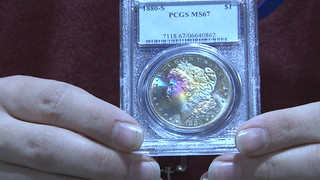 Cool Blast White Morgan, Toned
Morgan Dollar and Toned Buffalo Nickel at Long Beach Expo.
Cool Blast White Morgan, Toned
Morgan Dollar and Toned Buffalo Nickel at Long Beach Expo.
Joshua Lockard, Comet Coins, David Lisot, Interviewer, CoinTelevision.com.
Traveling numismatic reporter David Lisot interviews 18 year coin trader Joshua Lockard and brings you cool coins from the Long Beach Expo including a blast white 1880-S Morgan dollar PCGS MS68PL, a toned 1880-S Morgan dollar PCGS MS67, and a 1919 toned Buffalo PCGS MS66.
An excerpt of the video is available for viewing on the Coin Television YouTube Channel at:
https://youtu.be/Y9SOdCrwFBc

YELLOW FEVER AT THE U.S. MINT
This article from The Conversation examines how the U.S. Mint paid and retained its workforce during the 1793 work stoppage caused by the yellow fever pandemic. -Editor
Fever pains in the early republic
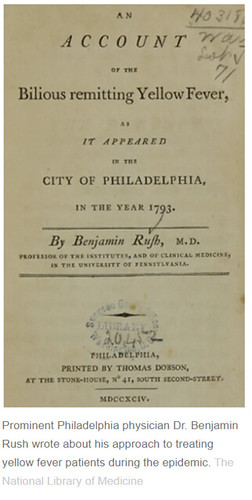 As a historian of infectious
disease, I see familiar patterns emerging in this pandemic that date back to the early republic. In the 1790s, yellow fever became epidemic in the Caribbean islands and grew into
a pandemic that reached the United States, Spain and Italy. It appeared in the U.S. capital, Philadelphia, in 1793, five years after the ratification of the U.S. Constitution.
As a historian of infectious
disease, I see familiar patterns emerging in this pandemic that date back to the early republic. In the 1790s, yellow fever became epidemic in the Caribbean islands and grew into
a pandemic that reached the United States, Spain and Italy. It appeared in the U.S. capital, Philadelphia, in 1793, five years after the ratification of the U.S. Constitution.
For the next decade, yellow fever erupted sporadically in Philadelphia and other populous coastal cities and towns. The outbreaks shut down businesses, suspended court sessions, and drove residents to flee.
During the first outbreak of 1793, a flour miller summed up the experience with these words: “I want to be doing something, but the Fever in Philadelphia has thrown us all out of our Geers.”
The pandemic forced Americans to tackle some of the questions that have surfaced in the past week: Would some people risk exposure to the virus in order to earn wages? Should employers allow workers to stay away from their jobs because of the risk of infection? How would families who relied on daily or weekly wages pull through?
Neither state nor federal lawmakers tried to answer these questions in the 1790s. But federal agencies had to respond as employers. The United States Mint, which produced the young nation's coinage, devised the most effective response.
Protecting workers in a pandemic
To protect the currency supply, the director of the U.S. Mint in Philadelphia suspended operations during each outbreak of yellow fever. Letters in the Mint's archive show that he
put workers on furlough with a guarantee of half pay for the two to three months that yellow fever lasted.
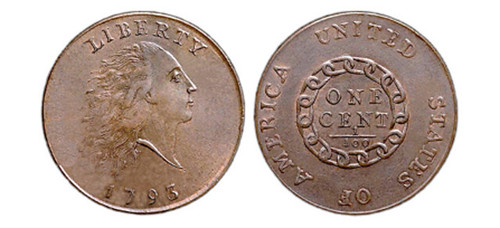
A copper penny produced in 1793 by workers at the U.S. Mint in Philadelphia.
This policy became the Mint's standard response to yellow fever and was applied six times over eight years.
Most workers received their pay after the outbreak, but highly skilled workers at the rank of officer could obtain their full quarterly pay in advance. Then, as now, the financial pains of a pandemic did not hit all classes equally.
The U.S. Mint's response to yellow fever struck a balance between workers' and employers' needs. Workers put on furlough were guaranteed jobs when the public health crisis was over. Meanwhile, the Mint secured their loyalty by promising back pay, so it was able to resume operations quickly after each outbreak.
Today, once again, business leaders and politicians are compelled to respond to a pandemic. State and federal legislators are taking bold steps to counter anxiety with assurances of stability. And they are developing new safety nets for workers made vulnerable by the coronavirus. As lawmakers consider their options, there are lessons to be found in U.S. history about sustaining workers during a public health crisis.
The Conversation is an independent and not-for-profit news organization. They reach out to leading scholars across academia for unbiased insight on news of the day. Consider signing up for their daily email newsletter or making a donation to help fund independent journalism. -Editor
To read the complete article, see:
How one federal agency took care of its
workers during the yellow fever pandemic in the 1790s
(https://theconversation.com/how-one-federal-agency-took-care-of-its-workers-during-the-yellow-fever-pandemic-in-the-1790s-134297)
To sign up for The Conversation newsletter, see:
Get newsletter The Daily (https://theconversation.com/us/newsletters/the-daily-3)
Dave Bowers also wrote on this topic for his Coin Update blog. -Editor
Turn on the television or check the news on the Internet and 90% of the coverage seems to be about the coronavirus pandemic. Events, including coin shows, have been canceled left and right. Self-isolation is being practiced across the land.
Meanwhile, coin auctions and other commerce is continuing without problems, thanks to the Internet. The Stack's Bowers Galleries sale of a few days ago was very strong as people were able to participate online. I have not heard of any problems with coins in holders or with books, and feel that it is easy enough to wipe the surface of anything you get from an outside source.
As of this writing, the four mints in the United States are still open. History tells us that over 200 years ago yellow fever epidemics in Philadelphia forced the closing of the Mint on occasion. Yellow fever was rampant in the late summer of 1793, and Joseph Wright, a distinguished engraver who prepared certain pattern coins in 1792 and the Liberty Cap cent of 1793, was among those taken by it. In 1797 the fever struck again, forcing many people in Philadelphia to go to the countryside. The Mint closed in late August and did not reopen until the end of November. In 1798, and again in 1799, the dreaded yellow fever epidemic struck the Philadelphia area in all its fury. People fled for their lives, but even though the Mint was closed for several months in each of these years, coinage resumed soon after reopening with a minimum of trouble. In 1803, the fever struck again and the Mint was closed for six weeks. Indeed, a lengthy essay could be written on the fever and coinage.
To read the complete article, see:
Bowers on collecting: Numismatics in the time of coronavirus
(http://news.coinupdate.com/bowers-on-collecting-numismatics-in-the-time-of-coronovirus/)
ROYAL MINT RETOOLS TO MAKE MEDICAL VISORS
David Pickup forwarded this report on how the Royal Mint is retooling to make medical visors. Thanks! This is great to see. -Editor
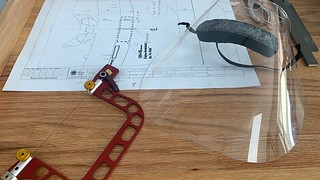 The Royal Mint has begun mass
manufacturing medical visors to protect frontline NHS staff from coronavirus.
The Royal Mint has begun mass
manufacturing medical visors to protect frontline NHS staff from coronavirus.
Based in Llantrisant, engineers at The Royal Mint developed a medically approved visor design which they can produce thousands of each day.
The first batch of visors are already in use at The Royal Glamorgan Hospital in south Wales.
Health care workers have expressed concern over the amount of PPE available to them, despite Welsh Government reassurance that there is enough to go around.
The Royal Mint, usually known for making money and coins, are turning their focus to helping protect people against COVID-19 by making valuable personal protective equipment (PPE).
Engineers at the site found a basic design for medical visors online. They then adapted and developed their own prototype, which was approved for medical use within 48 hours.
The design will also soon be released online, enabling other companies to manufacture even more.
The Royal Mint say they can produce thousands of masks every day, subject to getting enough of the raw components.
Leighton John, Director of Operations for The Royal Mint said: “My sister works for the NHS and it really focuses your mind on the challenges they are facing, and the opportunity we have to support them.
“On Wednesday at 9am we knew nothing about medical visors, but we set our engineers the task of developing essential medical equipment which could be easily made on site – within seven hours they'd created a medical visor, and within 48 hours it was approved for mass manufacture. We'll shortly post the specifications on our website to enable other firms to make them too.
“We are now developing the production line, and urgently calling for help to source 1.0mm PET clear plastic which is in low supply across the UK. We believe firms will have this in stock, and we'd urge them to get in touch with us so we can continue to support our NHS.”
Perhaps we could have a poster of Rosie the Royal Mint Worker?
To read the complete article, see:
Royal Mint makes medical visors to help protect NHS
staff from coronavirus (https://www.itv.com/news/wales/2020-03-27/royal-mint-makes-medical-visors-to-protect-nhs-staff-from-coronavirus/)
To read about a sports company doing something similar, see:
A sports company started making medical gear instead of hockey visors. It wants
others to help. (https://www.washingtonpost.com/sports/2020/03/28/bauer-hockey-face-shield-coronavirus/)
For more information on the iconic poster, see:
Rosie the Riveter Inspired Women to Serve in
World War II (https://www.defense.gov/Explore/Features/Story/Article/1791664/rosie-the-riveter-inspired-women-to-serve-in-world-war-ii/)
PERSPECTIVES ON THE POGUE VII SALE
Last week's issue was massive and one for the record books in other ways thanks to the great input from many supporters and readers including Alan Weinberg, whose fantastic you-are-there report from last week's coronavirus-shutdown-impaired Stack's Bowers auctions was my favorite article by far. Thanks again! -Editor

Safely back home Alan Weinberg writes:
"I've received a number of congratulatory emails regarding the SB auction review. Good job constructing what appeared to be the longest E-Sylum I can recall.
The Monday online session was also astonishingly active with very strong bidding. Got to be cabin fever and a lack of shows as high condition was not a factor there as it was a contributing factor Wednesday thru Friday."
Harvey Stack wrote to Alan:
"It takes someone like you put your experiences about the March Stack's Bowers sale, that shows just what efforts we made, the unbelievable experiences you encountered, (even driving at 80+ on a California highway), the running you did from place to place, and then after you were a winner for few lots to take the time and effort to report to all what you encountered, is sincerely appreciated by me and the rest of the crew.
"I hope the readers appreciate the fact that in order to help and serve them that we did everything we could do (plus) to make the sale successful. All the consignors thanked us for what we did and accomplished.
"By the way, this is not the first sale we sold under adverse conditions. For example, we held sales during the worst snow storm in the 1950's (the Schmandt sale), and the day Kennedy was shot (with the advice of the State Department). During the blackout in the 1970's that Stack's did re-schedule, the Black Monday severe drop of of 20% in 1987 and now with the "shut down" of operations this year, it proves our soldiers ready to serve and "make it happen and be successful!"
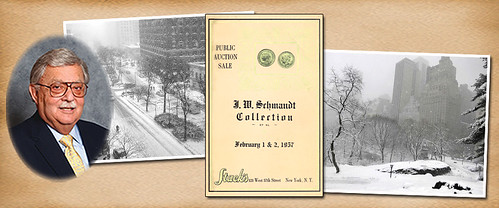
Linked below are earlier articles about the Schmandt sale and the Blizzard of 1957.
Here's E-Sylum supporter Doug Winter's perspective on the Pogue VII sale from his March 23, 2020 blog. -Editor
You couldn't have picked a more dire set of circumstances faced by Stack's Bowers for their various March coin and paper money auctions. After the Covid-19 virus cancelled the Baltimore coin show, the firm grappled with the very difficult questions forced by the crazy and rapidly-getting-crazier events of 2020. To cancel or not to cancel, that was the question.
Possessed with cojones the size of California, the decision was made to move the sale to the West Coast. When I heard this news I was pretty amazed but I totally understood Stack's Bowers' position: they were financially committed and with things likely to get worse in the coming weeks, it ultimately made sense to go ahead and sell the coins.
My assumption was that the Pogue Sale would do well no matter the circumstances. The coins were absolutely amazing and there weren't that many of them. Given the wealth of the Pogue family and the circumstances associated with the collection, it seemed unlikely to me that the family would make the decision to postpone the sale.
As I write this recap, the day after the sale, I am amazed at a number of things. First of all, I'm amazed at the scope of the participation. I'm in self-quarantine (and have been for close to two weeks) so I wasn't going to attend live (I participated by internet and phone bidding but this is no different from how I've approached auctions for at least five years) but the Fear of Gatherings didn't keep dealers from viewing and bidding live. Secondly, while I'm not surprised by the prices realized, I'm amazed by them. It takes guts to spend $2,500, $25,000 or even $250,000 on a coin after collectors have been dealt a world of hurt by the economic impact of the last few weeks. Kudos to the collectors who saw the opportunity to buy once-in-a-generation coins and overcame the fear we are all feeling right now.
So, you ask, how did the sale do? Coins under $10,000 were exceptionally strong. Coins in the $10,000-50,000 mostly did very well. The only area of weakness in the sale was the ultra-expensive coins, although there were some very expensive coins which did really well.
Here are a dozen rare gold coins from the sale along with my perspectives and what the prices realized mean in today's ultra-volatile market.
See Doug's complete blog post online for much more. Here are a couple of the coins he highlighted. -Editor
4. LOT 7334: PCGS/CAC MS65 1845-D HALF EAGLE
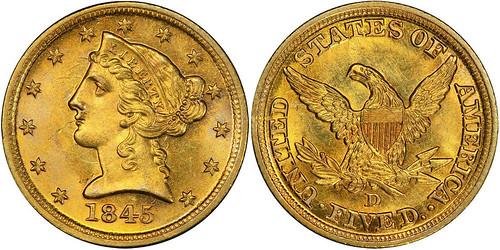
The Pogue Collection contained only a single Dahlonega coin, but what a coin it was: a Gem 1845-D half eagle with a pedigree which included Norweb, Bass, and yours truly. This is one of just four Dahlonega half eagles of any date graded MS65 by PCGS and it is the only piece likely to be available for some time.
This coin had last sold for $80,500 in August 2006 which I regarded as an extremely strong price at the time; I had paid $47,500 for it in partnership with another dealer in 2003 and I then sold it to a West Coast collector.
The coin sold for $96,000 which I regard as a very strong price; I felt the coin was going to bring around $70,000. The fact that it was the only CAC approved Dahlonega half eagle in MS65 (with none finer) gave it a broad sense of demand.
8. LOT 7338: PCGS/CAC MS66 1848-O EAGLE
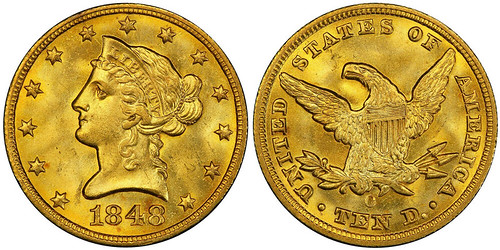
I've been in love with this coin since I first saw it, raw, in the James Stack Sr. sale held back in 1994 when it brought $154,000. It's the single finest No Motto New Orleans eagle in existence and it is one of the two best No Motto eagles of any date (the other, dated 1852 and graded MS66+ by PCGS/CAC, was also in the sale and I purchased it for $288,000).
The owner of the New England Collection of New Orleans gold coinage has wanted this coin for many years and when we learned it was going to be offered in the Pogue sale, he was excited. We had a number of discussions about what the right price was for the coin and who would be the likely competition.
I purchased the coin for $240,000 which I believe was well under market value. The fact that the Tyrant Collection contained a nice PCGS/CAC MS64 likely saved me $100,000+.
To read the complete article, see:
The Pogue VII Sale: My Perspective Through A Dozen Coins
(https://raregoldcoins.com/blog/2020/3/23/the-pogue-vii-sale-my-perspective-through-a-dozen-coins)
To read the earlier E-Sylum articles, see:
THE SCHMANDT SALE AND THE BLIZZARD OF 1957 (https://www.coinbooks.org/esylum_v18n08a19.html)
THE SCHMANDT SALE AND THE BLIZZARD OF 1957, PART 2 (https://www.coinbooks.org/esylum_v18n10a23.html)
AUCTIONS IN A WORLD OF CORONAVIRUS (https://www.coinbooks.org/v23/esylum_v23n12a14.html)
CORONAVIRUS UPDATES: MARCH 29, 2020
Here's another batch of updates from E-Sylum readers. Hang in there, everyone! -Editor
Bob Rhue, Denver
Bob Rhue writes:
"I always so enjoy The E-Sylum. Being cooped up for likely a number of months now I'll be able to have the time to read more of the links that you include in so many of the articles. "
Isaac Newton's Plague-cation
In his March 21, 2020 Maven Game newsletter, David Moldawer writes:
"Not long after Isaac Newton earned his bachelor's degree from Cambridge University, the entire school closed down due to the plague. (Sound familiar?) Young Newton must have been frustrated to find himself back home in gloomy Woolsthorpe, stuck in the house with nothing to do after experiencing the excitement and discovery of university life. He spent more than a year mostly in his room and, with nothing better to do than play with prisms and apples, worked out optics, gravity, and calculus. To this day, we refer to 1666 as Newton's Annus Mirabilis, or "Miracle Year."
OK, so probably none of us are going to invent a new branch of science or mathematics or prove parts of the General Theory of Relativity in our period of down time, but this is a good reminder that we can all continue to be productive in between bingewatching all the episodes of the favorite shows we missed while we were busy living our normal lives.
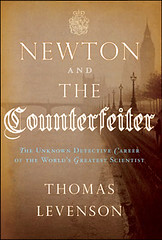 Finish that half-done
presentation for your local club, write an article for publication, organize your collection or library, browse the online collections of the ANA or ANS, or maybe read up on
Newton's connection to numismatics - his productive stint as the head of the Royal Mint.
Finish that half-done
presentation for your local club, write an article for publication, organize your collection or library, browse the online collections of the ANA or ANS, or maybe read up on
Newton's connection to numismatics - his productive stint as the head of the Royal Mint.
What numismatic projects are you doubling down on now? Share a report with us and let us know how the rest of us can help. As David writes, "Whether our lockdown lasts one month or one year, the time will pass however you choose to spend it. Spend it wisely." -Editor
Some useful links:
• The American Numismatic Association Edward C. Rochette Money Museum (https://www.money.org/money-museum)
• American Numismatic Society Online Resources (http://numismatics.org/resources/)
• The Maven Game: miracle year
(https://mavengame.com/2020/03/miracle-year/?ck_subscriber_id=526559791)
• David Moldawer's web site (https://bookitect.com/)
• NEW BOOK: NEWTON AND THE COUNTERFEITER BY THOMAS LEVENSON (https://www.coinbooks.org/esylum_v12n31a09.html)
• BOOK REVIEW: NEWTON AND THE COUNTERFEITER (https://www.coinbooks.org/esylum_v12n32a03.html)
American Numismatic Association, Colorado Springs
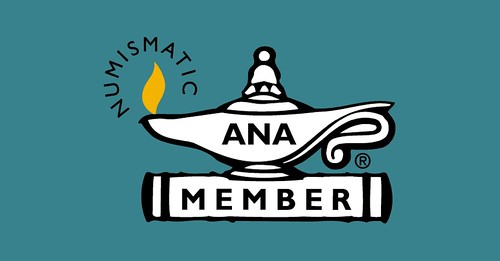
In an email to the membership, American Numismatic Association Executive Director Kim Kiick writes:
"Sharing our collecting passion with others is part of what makes the hobby so enjoyable, and the ANA offers an abundance of online programs that can keep you connected to the ANA community. As a matter of fact, we recently launched a members-only Facebook group at facebook.com/groups/anamembers/ where members can share in a safe environment all things numismatic (no trading or advertising allowed). And we'll be creating more online content in the weeks ahead to keep you entertained, educated and engaged.
"I also want to remind you that your membership includes access to The Numismatist archives from 1888 to the present via Exact Editions at money.org/thenumismatist/digitalarchives. (Call us at 800-514-2646 if you need assistance logging in.) And Money Museum virtual exhibits are available at money.org/money-museum/virtual-exhibits. Young collectors in your household can find all kinds of ways to get involved with games, quizzes and coin projects at money.org/young-numismatists.
"ANA President Steve Ellsworth, your Board of Governors and I also are working on contingency plans for Summer Seminar and the Pittsburgh World's Fair of Money, should it be necessary to cancel these events to keep our members and community safe. Information will be posted on money.org as updates become available.
"Because Colorado's Governor has issued a “stay at home” directive, the ANA team is working remotely to serve you. Rest assured that our phone lines and email are open and staff is prepared to be responsive to your inquiries, (although it may take a tad longer than usual); your patience is appreciated."
Kolbe & Fanning, Ohio & California
David Fanning of Numismatic Booksellers Kolbe & Fanning writes:
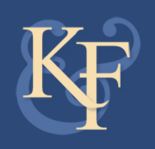 "We're doing fine here in Ohio, and
George is ok in California. The only people in our office are Maria and me, so we're able to go in when we want (though I've been working at home about half the time and Maria has
been staying put). As I write, I'm participating in the Birmingham Assay Office Library sale online, so life goes on. Our retail sales from the website have been ok. Our main
question is whether or not our next sale catalogue will be printed or purely digital—if the printer is closed, then we may have to experiment. We'll see."
"We're doing fine here in Ohio, and
George is ok in California. The only people in our office are Maria and me, so we're able to go in when we want (though I've been working at home about half the time and Maria has
been staying put). As I write, I'm participating in the Birmingham Assay Office Library sale online, so life goes on. Our retail sales from the website have been ok. Our main
question is whether or not our next sale catalogue will be printed or purely digital—if the printer is closed, then we may have to experiment. We'll see."
To browse the Kolbe & Fanning web site, see:
https://www.numislit.com/
Julian Leidman of Bonanza Coins, Silver Spring, Maryland
Julian Leidman writes:
"I've been going to Bonanza everyday and getting work done. eBay orders are every day. Just a few customers at the store in recent days, although 90% of the calls are about gold and silver. Pretty much sold out of bullion items, even at very high premiums. Eating breakfast at home, lunch delivered to the store and pick up takeout for dinner. Strange is an understatement."
To browse the Julian's web site, see:
https://juliancoin.com/
Harry Laibstain, Norfolk, VA
Harry Laibstain writes:
"Due to my concern for my staff we are going to an as needed basis for being in the office. It's a partial shutdown that I hope will be reasonably short lived as the curve flattens. I suspect 2-6 weeks. We will continue to do a biz but I can't really try too hard right now.
"That said we have been evolving our business model and putting more coins onto our site, and at lower price points. Business was pretty decent as we were getting it rolling. We have tripled what we had. More listings are coming but there will be some delays in getting packages mailed out. Auction business is the beneficiary of shows closing down and we have gotten decent to pretty good results on our consignments that were already in the pipeline.
"At present the coin market is proving to be incredibly resilient, in the face of an international pandemic and what will surely be a severe recession. Overall I don't think the hobby will be affected in the long run except that coin shows will suffer and online trading platforms and Auctions will grow stronger, a trend that was already playing out before the pandemic.
"It's not dissimilar from the Amazon effect on shopping malls. Shows may very well become too costly and now too dangerous for anything but more decline. Could even be the end of an era for me. I have been traveling to shows for forty years. I'm going to have to learn some new moves on the computer. Check out my site - it will continue to grow. "
To browse the HLRC web site, see:
Harry Laibstain Rare Coins (http://www.hlrc.com/)
Crises have a way of accelerating the inevitable. I've never been one to believe coin shows are going the way of the dodo bird, but I do believe this year will be a huge boost toward online numismatic commerce. Click on those ads, folks - dealer and auction web sites are where the activity will be. -Editor
Bob Steinberg, Raleigh, North Carolina
Bob Steinberg of Steinberg's Inc. writes:
"As most events (including coin shows) have been shut down due to the coronavirus (covid-19) and many of us are stuck at home (or will be shortly) due to self quarantining and social distancing---this might be a good time to try and do some business via email or telephone--working on our hobbies from home--checking out various websites on the internet, etc---
":Our firm--like many others--are still trying to earn a living buying and selling rare coins---our firm specializes in gold coins of the world---if you are thinking about selling some or all of your holdings--please consider offering us anything scarce or rare in world gold--especially high grade older numismatic material. It can be "raw" (uncertified) or certified graded by NGC, PCGS, ANACS, ICG, etc.
"On the other hand--if you are still actively collecting or dealing in world gold please take a few minutes to check out our current inventory on our website: www.steinbergs.com We post our new purchases on a weekly basis--and all of our most recent "newps" from the Atlanta ANA show from a few weeks ago are now up on our website!
"Who knows when the next major coin show will actually take place? Maybe it will be the Pittsburgh ANA in August? Nobody knows---but in the meantime let's all try and do some business together--buying or selling--since we are all in the same situation!"
To browse the Steinberg's Inc. web site, see:
STEINBERG'S INC. (http://www.steinbergs.com/)
Students hold graduation ceremony in Minecraft
Here's a March 15 item I just came across about one creative way for dealing with school closures. I don't know what the numismatic equivalent is, but I'm we'll see a number of new approaches in the coming weeks. -Editor
 As usual, kids are way ahead
of adults.
As usual, kids are way ahead
of adults.
Japanese schools have been closed for over two weeks now due to coronavirus quarantine, and they will remain closed until after spring vacation.
Because the Japanese school year ends in March and begins in April, for many students this closing period means that they mill miss their graduation ceremonies.
But some creative elementary school graduates in Japan came up with a great workaround. If they couldn't have a graduation ceremony at school, then why not have one digitally in a place they all meet often anyway… in Minecraft!
To read the complete article, see:
Japanese students hold graduation ceremony in
Minecraft amid school cancellation (https://soranews24.com/2020/03/15/japanese-students-hold-graduation-ceremony-in-minecraft-amid-school-cancellation/)
Tell us what YOUR numismatic organization is thinking of doing differently these days. Embrace the weirdness! -Editor
To read the earlier E-Sylum article, see:
CORONAVIRUS UPDATES: MARCH 22, 2020 : Virtual Hangouts: Embrace the weirdness
(https://www.coinbooks.org/v23/esylum_v23n12a15.html)
Doug Winter, Portland, OR
Doug Winter writes:
"Irma and I are well. We began self-quarantine nearly three weeks ago. I'm still going out three or four times per day for walks. I'd say the two things I miss most right now are restaurants and sports.
"I'm trying to adapt my business to the new normal. It's a challenge with no shows and, of course, the general uncertainty in the world. Coins still seem to be selling but right now much of the day to day business is bullion related."
To browse the DWN web site, see:
Douglas Winter Numismatics (https://raregoldcoins.com/)
Fred Weinberg, Encino, CA
Fred Weinberg writes:
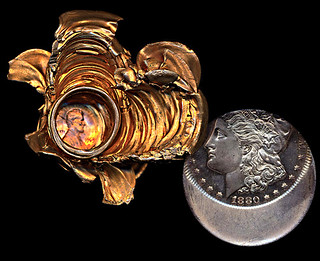 "We are in our office in
Encino for about two hours today, same as Tuesday, just to catch up on things here. (mail, packages, etc.)
"We are in our office in
Encino for about two hours today, same as Tuesday, just to catch up on things here. (mail, packages, etc.)
"We have stopped putting up errors on eBay for at least a few more weeks - getting a few, but very few, orders off our website.
"People don't want to spend money they might need in the next 4-12 months, so I anticipate a very 'slow' market for most of the rest of the year.
"It's expected to be bad here in Los Angeles in the next three weeks or so, and we will only come into our office building once or twice a week in the coming weeks, just for an hour or two as needed. Other than that, I'm a hermit!"
To browse the Fred Weinberg & Co. web site, see:
Fred Weinberg & Co. (https://www.fredweinberg.com/)
David Kahn, Maryland
David Kahn writes:
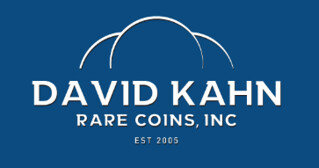 "Everyone here is healthy,
though we're going a bit stir-crazy, as I suspect is happening all over the world. But, we're healthy, and that is the most important thing, by far.
"Everyone here is healthy,
though we're going a bit stir-crazy, as I suspect is happening all over the world. But, we're healthy, and that is the most important thing, by far.
"All things considered, I think the coin business is doing quite well. I've spoken with a few friends about their situations, and most of the guys without shops that are closed, seem to be doing well. Online sales continue apace, though I wonder if that will continue over an extended period. Sure, boredom and a relatively captive audience probably helps those with a strong online presence, but the longer term effect of those potential buyers not working and/or getting hit with big portfolio loses probably results in slowing sales at some point. With the markets, both equities and metals, currently showing some signs of life, or at least stabilization, perhaps there is hope.
"Personally, I have enough inventory to last a couple of months, but many dealers are not similarly positioned. With PCGS closed for a week now, and without a reopening date, the supply of nice, fresh coins may start to run out fairly soon. That is the next hurdle that needs to be dealt with. I pray that everyone at PCGS is ready to hit the ground running when they do reopen. Liquidity in the coin market depends upon it."
To browse the DKRC web site, see:
David Kahn Rare Coins (https://www.davidkahnrarecoins.com/)
Künker, Osnabrück Germany
In a Friday March 27, 2020 email, the Künker firm writes:
"Our Spring Auction Sales 333-336 took place in the middle of the height of the worldwide corona crisis and under constantly tightened security requirements. Our concerns were enormous: How would the collectors react? In brief: The mood was positive and participation was high overall. For the more than 6,500 lots, we realized over 10 million euros surpassing by far the estimate for the sales that had been set at around 6.7 million Euros. The result of our eLive Auction 59 also confirms our opinion.
"Stay healthy and get well through these uncertain times."
To browse the Künker web site, see:
https://www.kuenker.de/en
Dave Hirt, Frederick, MD
Dave Hirt writes:
"We went to Budapest for Christmas and stayed for the winter, returning in early March. Just got back to America in time. I was glad for my weekly E-Sylum while I as there. Thanks! Still going through 3 months of mail and other things that piled up while we were gone.
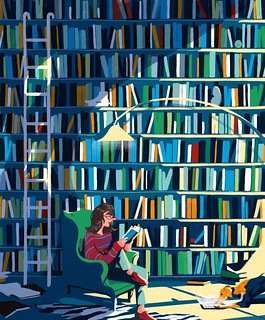 Reading your report of the WSJ
article on the Thomas Gresham book, I wondered why you did not mention the article on books, "Clutter or Comfort", the front page article in the Off Duty section of the
same paper. I thought it was an interesting article, with a large color picture of the library.
Reading your report of the WSJ
article on the Thomas Gresham book, I wondered why you did not mention the article on books, "Clutter or Comfort", the front page article in the Off Duty section of the
same paper. I thought it was an interesting article, with a large color picture of the library.
One thing is that the books all are about the same size, much different than my numismatic library. I would LIKE to arrange my books by subject, but that's impossible because of the different sized books. My books range from Von Bergen, Rare Coins (4" X 6 1/2"), A paper Ben Green early auction catalog is (3 1/2" X 6 1/4"), to Loubat on U.S. Medals (14 1/2" X 11"), with all sizes in between. Of course the champion is the Maris Coins of New Jersey (19" X 12"). I don't have bookshelf high enough for that one."
To read the WSJ article (subscription required) or watch a video blog in response, see:
Why Books Are Comforting in the Era of Coronavirus
(https://www.wsj.com/articles/why-books-are-comforting-in-the-era-of-coronavirus-11584646866)
Clutter or Comfort? Response to the Wall Street Journal (https://www.youtube.com/watch?v=vsKKB3mLU6A)
To read the earlier E-Sylum article, see:
NEW BOOK: GRESHAM'S LAW (https://www.coinbooks.org/v23/esylum_v23n12a07.html)
Fred Holabird, Reno, Nevada
Fred Holabird writes:
"Imagine this – five live internet bidding platforms in use for most auctions, all carefully picked. In fact, we work with several of these advanced forums to help make them, us, and the auction experience better for you. We bring new collectors to the table each and every auction, fostering new relationships with collectors who may not have been part of the mainstream of collectors at trade shows over the years.
"Buying on the internet is at an all-time high, and we understand how and why – that's why we do so much with our internet bidding platform “partners.”
"About trade shows - those shows held in your communities and larger regional or nationwide annual shows still, and always will be a big part of the collecting experience. Here you'll find your friendly dealer who has amassed an inventory of goods for sale. Sometimes you have to root through boxes; sometimes what you want will be right in front of you. Regardless, these shows are still the perfect public forum for collectors. They are places where you can meet fellow collectors, dealers and offer a tremendous learning experience.
"In the advent of Covid-19, we've necessarily seen shows cancelled. We were scheduled to hold a token auction at the Western States Token Society (WESTS) show in Santa Rosa tonight or tomorrow night, hosted by Merle Avilla and a host of local volunteers.
"Out West, the next big coin show is at the Long Beach Convention Center. If it's still on for June, and you've got time, go! We've also got the Gold Rush Show at the Nevada County Fairgrounds in Grass Valley on May 8 and 9.
"There are many more shows. There's probably one of some kind in every region of America every weekend. While many are suspended for Covid-19, we support their revival once we, as a country and society, have successfully conquered this pandemic. It may take a while, and the current plans appear good – social distancing, constant sanitizing, and staying home, particularly if you are sick. Along these lines, we are doing our part at our Reno headquarters, sanitizing twice a day, staying ten feet apart, and using the internet as much as possible. We also see great support from friends and clients in business here. Seven Troughs Distilling, named after the mining camp of the same name, and a company that has consulted with us in the past, has turned their production to WHO qualified sanitizer specifically for a local major hospital.
"While we work our way through the pandemic, it is important to realize we can assist. Our internet doors remain open, and we provide a huge platform from which to sell collections."
To browse the Holabird Americana web site, see:
http://holabirdamericana.com/
Shanna Schmidt, Oak Park, IL
In her March 27, 2020 Newsletter #148 Shanna Schmidt writes:
"As I sit here I am bidding in the Roma auction. Roma had to scramble to change their auction from a floor to online auction only. They have done a splendid job in my opinion. The auction was very intense and continues to be. There is spirited bidding and some very high hammers. The first portion of the sale (Stancomb) had record prices for Black Sea material. The Greek portion following afterwards was equally strong. A few pieces went under estimate but most coins did quite well. Roma also started opening coins at 60% of estimate versus the standard 80%. I believe this helped to entice bidders.
"The auctions moving forward from here will still take place but they will certainly all be online until the world has a breakthrough on the virus. "
To browse the Shanna Schmidt Numismatics Inc. web site, see:
https://www.shannaschmidt.com/
Clarke Auction Gallery, New York
The world of antiques saw a similar boost in online bidding. This Tiffany Lotus lamp brought $150,000. -Editor
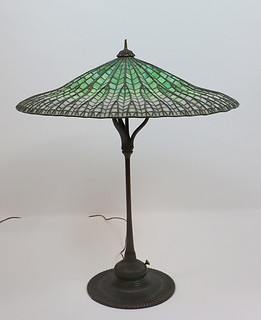 What a difference a month makes. Clarke
Auction Gallery's first two auctions of the year boasted good-sized attendance as usual but its March 22 sale, which came two days after New York State governor Cuomo issued a
stay-at-home order, saw online and phone bidding supplant in-house bidding.
What a difference a month makes. Clarke
Auction Gallery's first two auctions of the year boasted good-sized attendance as usual but its March 22 sale, which came two days after New York State governor Cuomo issued a
stay-at-home order, saw online and phone bidding supplant in-house bidding.
One might think this would have negatively affected bidding but if anything, the auction saw even more participation as the auction grossed just over a million dollars and went off without a hitch. Offerings in the sale were strong across the board overall with a diverse selection of top draw goods.
To read the complete article, see:
Tiffany lamps drive Clarke Auction to a million dollar
tally (https://artdaily.cc/news/122139/Tiffany-lamps-drive-Clarke-Auction-to-a-million-dollar-tally#.Xn9Al4hKhPY)
Copper's Antimicrobial Properties
Kavan Ratnatunga passed along this non-numismatic article with the subject line "Why we need Copper Coins back." Yes, some of the research was funded by the copper industry, but there seems to be a good argument for using more copper fixtures in public places. -Editor
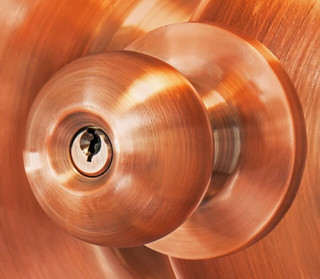 In China, it was called “qi,” the symbol for health. In
Egypt it was called “ankh,” the symbol for eternal life. For the Phoenicians, the reference was synonymous with Aphrodite—the goddess of love and beauty.
In China, it was called “qi,” the symbol for health. In
Egypt it was called “ankh,” the symbol for eternal life. For the Phoenicians, the reference was synonymous with Aphrodite—the goddess of love and beauty.
These ancient civilizations were referring to copper, a material that cultures across the globe have recognized as vital to our health for more than 5,000 years. When influenzas, bacteria like E. coli, superbugs like MRSA, or even coronaviruses land on most hard surfaces, they can live for up to four to five days. But when they land on copper, and copper alloys like brass, they begin to die within minutes and are undetectable within hours. “We've seen viruses just blow apart,” says Bill Keevil, professor of environmental healthcare at the University of Southampton. “They land on copper and it just degrades them.”
No wonder that in India, people have been drinking out of copper cups for millennia. Even here in the United States, a copper line brings in your drinking water. Copper is a natural, passive, antimicrobial material. It can self-sterilize its surface without the need for electricity or bleach.
Brass door knobs and handrails went out of style as architects and designers opted for sleeker-looking (and often cheaper) materials.
Now Keevil believes it's time to bring copper back in public spaces, and hospitals in particular. In the face of an unavoidable future full of global pandemics, we should be using copper in healthcare, public transit, and even our homes. And while it's too late to stop COVID-19, it's not too early to think about our next pandemic.
To read the complete article, see:
Copper kills coronavirus. Why aren't our surfaces
covered in it?
(https://www.fastcompany.com/90470650/transformative-architecture-year-after-year)
Virus Shut-In Reading: The Shelter
I ended last week's issue with an interview with my old friend Larry Brilliant, an epidemiologist who consulted on the film Contagion and warned of a virus outbreak like the one we find ourselves in today. Another friend, Robert Hoppensteadt of my local Nummis Nova group, published a fiction novel just last year in which a thawed mammoth corpse in Alaska unleashes a deadly virus. I asked him about how he thought today's coronavirus events compared with his novel's vision. -Editor
"My book's virus had a 10% survival rate and was twice as contagious as measles, so that's different. The way it's playing out though is eerily the same - a government wary of taking bold action early and ignoring doctors, it escaping via airports, deciding isolation was the only option. Also food panics etc. It of course diverges after that pretty quickly."
For more information, or to order Robert's book, see:
The Shelter Paperback – May 1, 2019
(https://www.amazon.com/Shelter-Robert-Hoppensteadt/dp/1625268858)
To read the earlier E-Sylum articles, see:
WAYNE'S NUMISMATIC DIARY: MARCH 17, 2019 : Another Author! The Shelter
(https://www.coinbooks.org/v22/esylum_v22n11a22.html)
LARRY BRILLIANT, NUMISMATIC INTERNET PIONEER (https://www.coinbooks.org/v23/esylum_v23n12a31.html)
Hair Freezing Contest
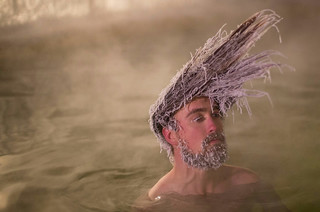 For grins here's
something non-numismatic to divert your attention: the Yukon Hair Freezing Contest. Someday maybe we'll all be confessing "Forgive me Barber, for it has been three months
since my last Haircut." -Editor
For grins here's
something non-numismatic to divert your attention: the Yukon Hair Freezing Contest. Someday maybe we'll all be confessing "Forgive me Barber, for it has been three months
since my last Haircut." -Editor
To read the complete article, see:
How to Win a Hair-Freezing Contest in Northern Canada
(https://www.atlasobscura.com/articles/what-is-a-hair-freezing-contest)
To read the earlier E-Sylum article, see:
CORONAVIRUS UPDATES: MARCH 22, 2020 (https://www.coinbooks.org/v23/esylum_v23n12a15.html)
BUYERS FLOCK TO BULLION AND COINS
As our dealer friends have noted, bullion and other hard assets are flying off the shelves these days. Here are excerpts from two stories on the topic. -Editor
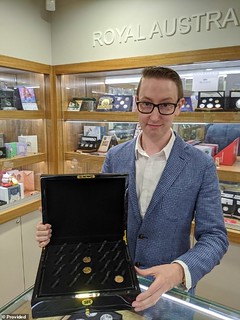 Gold and silver have become the
new toilet paper in Australia as investors pile into coins and bullion as a safe haven during the coronavirus panic.
Gold and silver have become the
new toilet paper in Australia as investors pile into coins and bullion as a safe haven during the coronavirus panic.
'Everyone is going bananas for gold and silver and we've seen a lot of excitement around rare coins, too,' said Numismatist Matthew Thompson of Downies Coins and Collectables in Melbourne.
Demand has surged with a 200 percent increase in inquiries for both bullion and rare coins, he said.
Buyers have cleared out most of the shop's stock of gold and silver coins and bullion.
'Normally these display cases are full,' he said, holding up a large black display case with just three coins.
'It's crazy at the moment, many dealers are completely cleaned out of physical stock.
Retail investors are turning to precious metals seeking a store of value as the Australian dollar drops below US60c.
Because bullion is in short supply- with silver almost unobtainable by some dealers - retail customers are turning to collectibles instead.
Mr Thompson said there was a lot of excitement around high-end rarities like the 1930 penny, with the shop having one specimen for sale at $27,500.
'A lot of our clients are also diving into the rare coins, as many people like the idea of having a diversified portfolio,' Mr Thompson said.
To read the complete article, see:
Gold becomes the new toilet paper:
Coin dealers report a huge increase in people buying bullion during the coronavirus pandemic
(https://www.dailymail.co.uk/news/article-8153433/Coin-dealers-report-huge-increase-people-buying-bullion-coronavirus-pandemic.html)
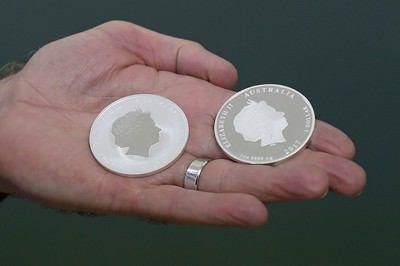
As swathes of the world economy go into lockdown from the U.K. to India, some businesses are ramping up, not down: one of the world's leading mints is adding shifts to boost production of refined precious metals including silver after worried investors depleted stock.
The Perth Mint -- Australia's largest, which has been in business for more than a century -- is diverting production resources into the popular 1 ounce Silver Kangaroo coin to meet a backlog of orders. An extra 7.5 hour shift has been added. Stocks of cast and minted-bar products have been cleared out.
Trading On The Floor Of The NYSE As Stocks Drop Richard Hayes in 2019.Photographer: Michael Nagle/Bloomberg “We're as busy we can possibly be, and we're seeing a lot of this stock going both into the U.S. and into Europe, where demand has just gone through the roof,” Richard Hayes, the mint's chief executive officer, said in an interview. “We're working to catch up with those backlogs as rapidly as possible.”
The coronavirus pandemic has triggered turmoil in precious metals markets, forcing the Royal Canadian Mint to suspend production and roiling prices. Some investors had to sell precious metals to meet margin calls and that, combined with a stronger dollar and lower industrial demand, dragged silver prices to the lowest level in 11 years. People are seeing the slump as a buying opportunity, especially in the U.S. and Germany, according to Hayes.
“Having been in this business for 25 years now, what I can say is that generally, there are more-than-adequate supplies of the underlying metal, but it may be in 1,000 ounce bar form, or a form other than what customers are wanting,” Hayes said. “At this stage, they're wanting 1 ounce silver coins.”
To read the complete article, see:
Top Mint Ramps Up Silver Coin Output After Demand
Surges (https://www.bloomberg.com/news/articles/2020-03-24/top-mint-says-demand-has-gone-through-the-roof-amid-turmoil)
HOBBIES ALL-IMPORTANT DURING CRISIS
An article by Jesse Robitaille in Canadian Coins News aptly summarizes the situation in numismatics today., Here's an excerpt - be sure to see the complete article online. -Editor
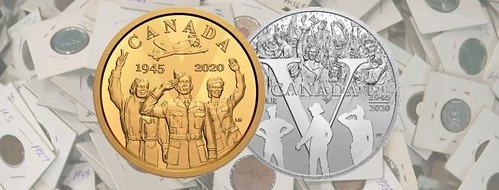
I'm preaching to the choir here, but in times of crisis, there's no end to the benefits of having a hobby.
We all know this, but it bears repeating: numismatics is good for the soul.
It's especially true today, when we're faced with never-ending updates on a gloomy situation that only seems to get worse by the hour.
In these bizarrely unprecedented times, with much of Canada under quarantine as COVID-19 continues to spread, we as collectors are fortunate to have numismatics at our disposal.
Like always, numismatics allows us to take our minds away from the burdens and stresses of everyday life. For centuries, the hobby has been a safe refuge from a chaotic world. Now more than ever, it's a way for us to keep calm, busy and mentally stimulated while we're all forced to stay at home.
Whether you're looking for education, entertainment or distraction, numismatics has something to offer. (And there's much more to it than simply collecting coins: beyond buying and selling, which you can still do as of the time of printing, there are countless other off-shoot activities such as research, writing, grading, exhibiting and more—and all of it extending into areas like history, geography, economics and science.)
THE CAMARADERIE CONTINUES
Think of all the friends you've made through numismatics over the years. Would your hobby be the same without them?
Just because we're all unable to attend shows and meetings, for the time being, doesn't mean we can't stay in close contact with our fellow collectors – something we at CCN strongly encourage.
After all, camaraderie is numismatics' defining feature.
As I write this, we at CCN are exploring ways to keep everyone connected, whether it's through existing Facebook pages or by hosting virtual seminars and meetings. We'll have more information soon at facebook.com/CanadianCoinNews.
To read the complete article, see:
Hobbies all-important during our current crisis
(https://canadiancoinnews.com/hobbies-all-important-during-our-current-crisis/)

MORE ON EARLIEST USE OF THE WORD 'NUMISMATICS'
Some time ago Hadrien Rambach provided a response on the earliest use of the word "numismatics", but I didn't have a chance to edit it for publication until this week. Hadrien alerted us to an article on the topic that he'd written in French and published in Revue belge de numismatique et de sigillographie (vol. CLXIV (2018), pp. 524-529).
The title "Numismatographie et numismaticite, nummophiles et numismanes : note à propos de divers termes désuets " roughly translates to "Numismatography and numismaticitis, nummophiles and numismaniacs: Notes on Various Obsolete Terms". Here is a Google translation of the article summary. -Editor
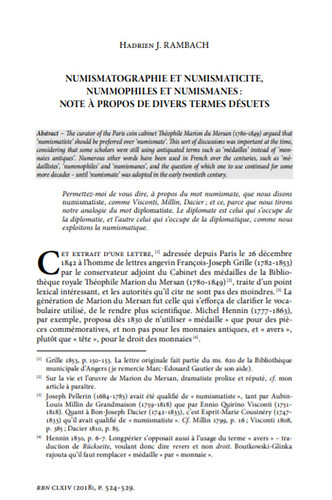 "According to Thierry Sarmant (Sarmant 2000, p. 70, note 5), the use of the word "numismatics" would
be attested as an adjective since 1579 (Le Pois 1579, p. 35 v.), Then the Dictionnaire de l'Académie recorded the substantive in 1803. The oldest occurrence of the
substantive adjective that Sarmant has found is in the sentence "You oblige me to give me news about numismatics, being in a distant country where we hear nothing said",
Found in a letter from Father Favart to the capitoul Du Vau (Bibl. Nat. De Fr., Manuscrits, fr. 15186, fol. 87, Reims, June 23, 1732).
"According to Thierry Sarmant (Sarmant 2000, p. 70, note 5), the use of the word "numismatics" would
be attested as an adjective since 1579 (Le Pois 1579, p. 35 v.), Then the Dictionnaire de l'Académie recorded the substantive in 1803. The oldest occurrence of the
substantive adjective that Sarmant has found is in the sentence "You oblige me to give me news about numismatics, being in a distant country where we hear nothing said",
Found in a letter from Father Favart to the capitoul Du Vau (Bibl. Nat. De Fr., Manuscrits, fr. 15186, fol. 87, Reims, June 23, 1732).
In fact the first known occurrence of "numismatics" - in Greek - is even older, since it dates back to 1565, in Belgium (Lampson 1565, p. 30; Lampson 1949, p. 74: "It is therefore Lambert Lombard that the Belgians owe, in addition to these advances of which I spoke in the art of painting and of which he said himself partly indebted to these ancient currencies, this taste so estimable of numismatics (in Greek), word which does not seems to me not too badly suited to this kind of knowledge."
I thank François de Callataÿ for providing me with a pre-print version of his forthcoming study)."
Thank you! The Hobby of Kings has been around for quite some time, and will be for much much longer. -Editor
To read the earlier E-Sylum article, see:
THE FIRST KNOWN USE OF THE WORD 'NUMISMATICS'? (https://www.coinbooks.org/v23/esylum_v23n01a15.html)
NOTES FROM E-SYLUM READERS: MARCH 29, 2020
Query: Numismatic Postcard Albums
Web site visitor Weronika Buchalska of western Poland (near Berlin) writes:
"I have just read your article on The E-Sylum web site and I found information about coin card albums. I would like to know is it possible for you to support me with some more information. I received one album from my family (connection with Walter Erhard)."
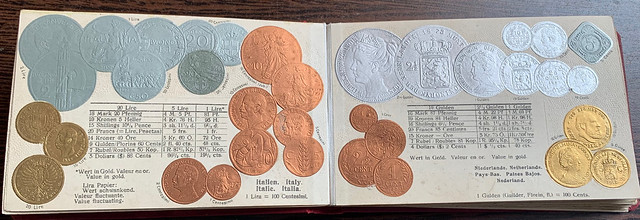

More more images, see this album on our Flickr page:
https://www.flickr.com/photos/coinbooks/albums/72157713662152918
(https://www.flickr.com/photos/coinbooks/albums/72157713662152918)
I have no other information on these besides what we've published in the earlier articles. Would anyone have anything to add about Weronika's album? -Editor
To read the earlier E-Sylum articles, see:
EMMLER AND HIEMBRECHT INFORMATION SOUGHT (https://www.coinbooks.org/esylum_v08n01a12.html)
NUMISMATIC POSTCARDS (https://www.coinbooks.org/esylum_v08n02a14.html)
NUMISMATIC POSTCARDS PICTURING U.S. COINS (https://www.coinbooks.org/esylum_v17n05a25.html)
READER COMMENTS ON NUMISMATIC POSTCARDS (https://www.coinbooks.org/esylum_v17n23a16.html)
Query: Numismatic Athenaeum
Here's a short excerpt from an article by Pete Smith in the Spring 2020 issue of our print journal The Asylum. It's about an attempt to create a club for numismatic bibliophiles prior to the eventual creation of the Numismatic Bibliomania Society in 1979. -Editor
The November 23, 1974, issue of Numismatic News Weekly contained this brief article:
"Book Club Formed For Numismatists
A book club for collectors, Numismatic Athenaeum, has been organized to promote study and understanding of all phases of numismatics, to assist members in obtaining new books and
reference works at discount prices, and to disseminate numismatic information on Oriental, Western, Ancient and modern subjects and also in the fields of syngraphics and exonumia.
Membership is open to collectors who are serious about the hobby and information is available from The Numismatic Athenaeum, 614 S. Johnson St., Iowa City, Iowa 52240."
It was not hard to figure out that 614 South Johnson Street was the residence of Patrick D. Hogan. Patrick Dennis Hogan was born on March 18, 1939. As he joined the American Vecturist Association, he gave his profession as repairman.
Hogan joined the Numismatic Bibliomania Society as a Charter member but did not contribute any article to The Asylum. The Newman Numismatic Portal has 245 citations for Hogan. They are references to club memberships and publications but include no background information. Hogan joined the American Numismatic Association in 1968. He was active with the Oriental Numismatic Society and served as Regional Secretary for North America until 1982. He was also active with Numismatics International as Life member #69 and as assistant editor for their newsletter from 1970 to 1973. He had an interest in exonumia and was a member of TAMS, the AVA and other token organizations.
Would anyone have more information on Patrick Hogan or the Numismatic Athenaeum group? Is Hogan still alive? Have any of our old-time readers met or known him? Any information you can provide would be appreciated. Thanks. -Editor
For more information on The Asylum, see:
ASYLUM SPRING 2020 ISSUE PUBLISHED (https://www.coinbooks.org/v23/esylum_v23n08a02.html)
Medieval Silver Sixpences Found in a Pudding
David Pickup writes:
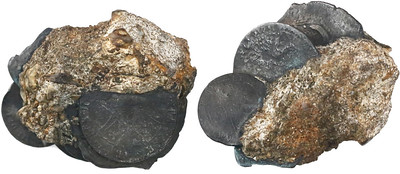 "Detectorists in Buckinghamshire
have unearthed a hoard of medieval silver sixpences found in a pudding. They have been detecting for thirty years but never got anything other than cans and horseshoes. When they
tried their machinery on a pudding they discovered a hoard of coins. Joe said first one or two coins then found loads in his bowl. Fred said he was lucky did not put custard on
the pudding or he would never have seen them glinting.
"Detectorists in Buckinghamshire
have unearthed a hoard of medieval silver sixpences found in a pudding. They have been detecting for thirty years but never got anything other than cans and horseshoes. When they
tried their machinery on a pudding they discovered a hoard of coins. Joe said first one or two coins then found loads in his bowl. Fred said he was lucky did not put custard on
the pudding or he would never have seen them glinting.
"A spokesman for the English Museum says putting sixpences in puddings was common in the Norman period. Saxons hid coins in puddings to stop Normans stealing their money. It is rare to find so many in one pie. The Doomsday Book contains lists of puddings, desserts and trifles. In olden days weights were measured in how much pudding people could eat in a day. A knight or squire could finish off a few pies and a rice pudding in a day but a ploughman would have to make a turnip pie last all week. It was common in the times of Richard I to hide silver pennies in puddings hence the expression “spotted Dick”. William the Conqueror was so called because he could finish off so many pies so quickly. He also introduced the quiche to England and forced Saxons to stop eating cheese pies.
"Joe thinks he may have swallowed some coins. By Treasure Law unless there is some change, Joe will be subject to an inquest and will have to be auctioned. Local detectorists are trying to raise money to preserve him for the nation.
"Coin collectors everywhere are encouraged to eat as many puddings and pies as possible. Have a good day."
Thanks. I'm not big on pudding, but maybe I'll start. Better prizes than Cracker Jack. -Editor
Ceylon Agri-Horticultural Show Medals
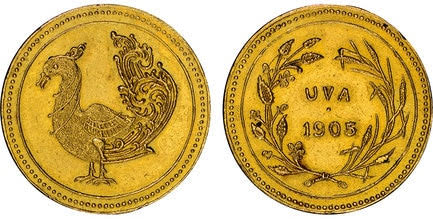
Last week Howard Daniel asked for assistance identifying the above medal. Julia Casey writes:
"I found this interesting auction listing for "Ceylon Agri-Horticultural" prizes with the UVA designation and a similar bird design at Dix Noonan Webb."
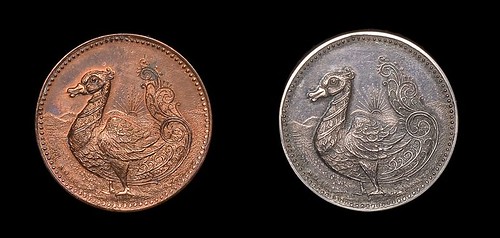
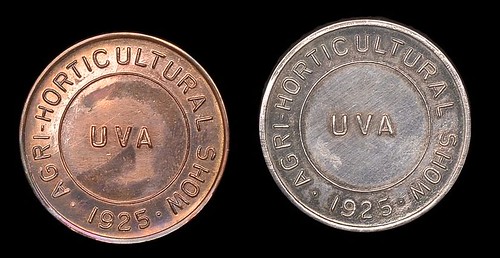
Kavan Ratnatunga of Sri Lanka writes:
"UVA is one of the 9 Provinces of Ceylon since 1896 and the bird is on the Province Flag. The Massacres the British did in 1848 in Uva are well described in what an American wrote in 1851. I have not focused on Ceylon Medals, as there are so many and not properly catalogued. A few of what I have, are posted in http://coins.lakdiva.org/medal/ ."

Flag of Uva Province, Sri Lanka
Thanks, everyone. Mystery solved! Kavan provided additional links (below). -Editor
Howard Daniel writes:
"I knew someone out there knew the source of the medal. Fantastic! I am upset with myself that I did not at all think about Ceylon but happy now the source has been solved. Thank you VERY much for your input."
James Ricks of Atlas Numismatics writes:
"Thank you very much for the information. We will send our piece for reholder."
For more information on Uva Province, see:
Uva Province (https://en.wikipedia.org/wiki/Uva_Province)
To read the earlier E-Sylum article, see:
The English in Ceylon. (http://books.lakdiva.org/moa/cornell/1851_english_in_ceylon.html)
To read the complete auction lot description, see:
CEYLON, Agri-Horticultural Show, Uva, 1925, medals
(https://www.dnw.co.uk/auction-archive/past-catalogues/lot.php?auction_id=443&lot_uid=286064)
To read the earlier E-Sylum article, see:
NOTES FROM E-SYLUM READERS: MARCH 22, 2020 : Cambodian, Burmese or Indian Hamsa Bird Medal?
(https://www.coinbooks.org/v23/esylum_v23n12a16.html)
Query: Potent HIV Treatments Medal
Jonathan Brecher writes:
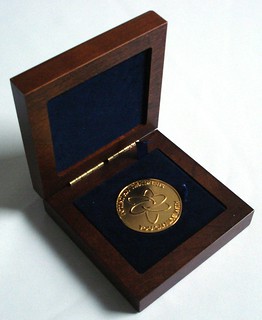 "Here's a piece I bought
recently that has me stumped and I wouldn't mind hearing if anyone else has ideas.
"Here's a piece I bought
recently that has me stumped and I wouldn't mind hearing if anyone else has ideas.
This is clearly a modern medal. AIDS wasn't on the public radar until the 1980s. This has NOTHING that I've found to identify it. There's no company name. I can't place the logo on either side. There's no artist signature. The edgemark lists composition but not maker. I'm drawing a blank.
Beyond all of that nothing, it's a very well made medal. It's in a very nice plush-lined wooden box that also has no identifying marks. The size and weight of the medal are somewhat non-standard — 44 mm, 66 grams (2.12 troy ounces).
Does anyone know who made this, or what company it was made for?"
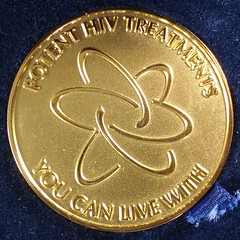
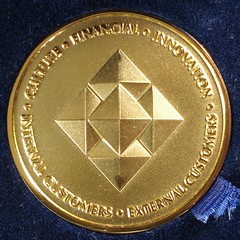

Interesting artifact from an earlier health emergency. Thoughts, anyone? -Editor
Roman Style Oreo Cookie Cameo
John Lupia writes:
"I saw this on Facebook: A sculptor, Judith G. Klausner posted her work, a Roman style cameo out of the creme filling of an Oreo!"

Cool! But wait - you mean we can't eat it? Tragic! There's an O. Henry story in here somewhere... -Editor
QUERY: VAIL MEDAL BROOCH
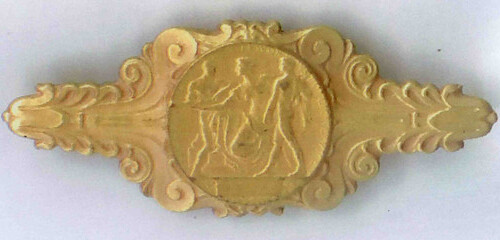
Dick Johnson sent this image a while ago and I only got around to editing the photo for publication this week. It's a brooch with a version of the Theodore Vail medal by Adolph A. Weinman. Has anyone seen one of these? For reference, here are images of the medal and links to earlier E-Sylum discussions. -Editor
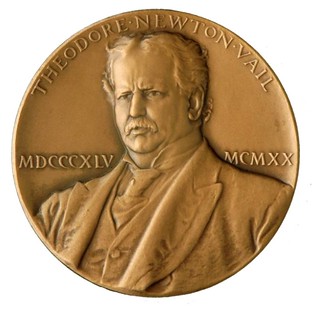
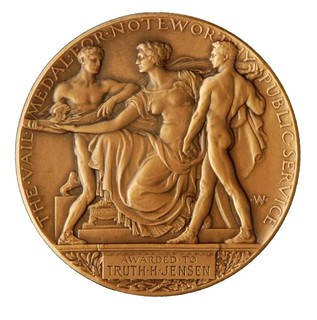
I reached out to my friend and fellow Nummis Nova member Jon Radel who is a collector of Vail medals. Here are his notes. Thanks! -Editor
Interesting.
That I don't believe I've ever seen a color photograph of before, certainly I've not seen one in person, but I've heard of them.
For a significant period of the Vail medal being issued (my way of hedging, as this aspect of the award is not all that well documented) I believe you were issued a brooch or a button with a miniature, depending on your gender.
See p234 of the May 1922 issue of The Numismatist, an early reference. At that time they were issuing the medals with a brooch of the reverse, the item you show, for women, and a lapel button for men.
A much more recent instance of the lapel button (now referred to as a "tie tac," at least by one eBay seller) is one awarded with a gold medal in 1987 and now on sale for eBay:
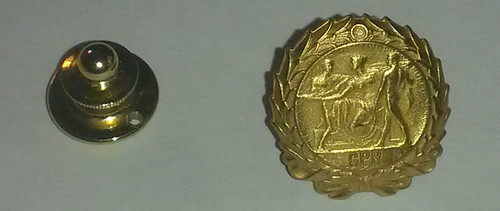
In that case there was also a 2-sided miniature on a chain:
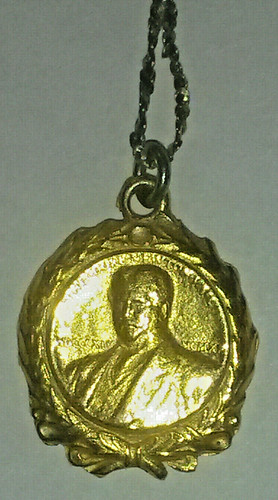
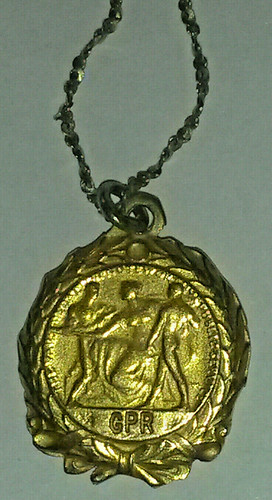
The recipient got a Carnegie medal also.
(As a side note: I'm not quite sure that the eBay seller understands the value of keeping sets together. The medal itself is being held back to possibly donate to an appropriate museum, but the ancillary bits are being sold piecemeal on eBay.)
Thanks! See the link below to the awardee's web site. It's an amazing story from start to finish, with excellent advice for anyone who should similarly find themselves suddenly in the fifteen-minutes-of-fame spotlight. -Editor
Dick Johnson adds:
"While doing inventory, I recognized it as the Vail medal. Research still hasn't found this particular piece pictured. Medallic Art Company made a lot Vail pieces, but this may be by a jewelry maker. It is truly a beautiful / dainty piece."
For more information on the event and award, see:
15 Minutes of Fame (http://gregoryprobertson.com/15minutesoffame/awards-honors/)
To read the complete eBay descriptions, see:
AT&T Gold
Vail Award Medal Tie Tac Awarded For Skydiving Air-to-Air Rescue
(https://www.ebay.com/itm/AT-T-Gold-Vail-Award-Medal-Tie-Tac-Awarded-For-Skydiving-Air-to-Air-Rescue/113846909241?hash=item1a81cdf939:g:MkUAAOSweGpc0JHa)
AT&T Gold
Vail Award Medal Necklace Awarded For Skydiving Air-to-Air Rescue
(https://www.ebay.com/itm/AT-T-Gold-Vail-Award-Medal-Necklace-Awarded-For-Skydiving-Air-to-Air-Rescue/113846803417?hash=item1a81cc5bd9:g:htQAAOSwok9c0J3e)
To read earlier E-Sylum articles, see:
1925 THEODORE N. VAIL MEMORIAL MEDAL (https://www.coinbooks.org/esylum_v17n25a10.html)
MORE ON THE VAIL MEDAL (https://www.coinbooks.org/esylum_v19n20a19.html)
MORE ON THE MINTER'S COSTUME
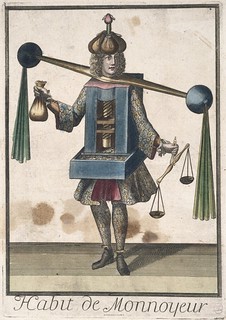 Last week Anne Bentley forwarded this
delightful if creepy image of a moneyer as one with his coin press. It came from a newly-released collection of images from a group of museums in Paris. E-Sylum readers
have found more background information on this unusual piece. -Editor
Last week Anne Bentley forwarded this
delightful if creepy image of a moneyer as one with his coin press. It came from a newly-released collection of images from a group of museums in Paris. E-Sylum readers
have found more background information on this unusual piece. -Editor
Daniel Demeo writes:
"It matters little, but the artist is anonymous. With a costume like that, a sure winner on Halloween, but is he giving treats from his sack of coins? Here's the link
to the museum association:
http://parismuseescollections.paris.fr/fr/musee-carnavalet/oeuvres/habit-de-monnayeur#infos-principales
."
Actually, it turns out that while that museum didn't know who the artist was, he's not anonymous after all. The work was part of a well-known series. -Editor
Ron Haller-Williams writes:
"A Google search on the exact phrase of the French wording (i.e. "habit de monnoyeur" - INCLUDING the quotes!) reveals all: Nicolas de Larmessin (or L'Armessin)
has sons, TWO of them confusingly also called Nicholas. Both the sons worked on a series "Les Costumes Grotesques: Habits des métiers et professions". This item, a
copper engraving, was published in 1695. There seem to be several different sizes. To see some more in the series, take a look at
https://www.google.com/search?q=%22Costumes+Grotesques:+Habits+des+m%C3%A9tiers%22&tbm=isch
."
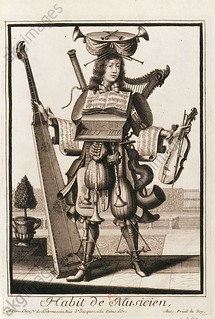
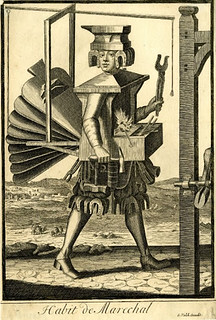
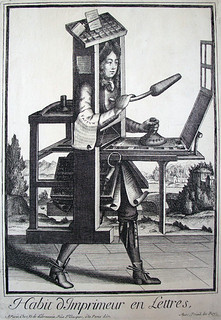
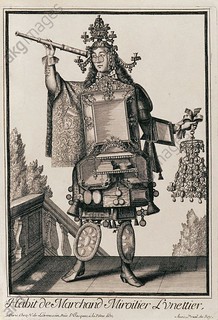
References:
https://fr.wikipedia.org/wiki/Nicolas_Ier_de_Larmessin
https://fr.wikipedia.org/wiki/Nicolas_II_de_Larmessin
https://fr.wikipedia.org/wiki/Nicolas_III_de_Larmessin
http://www.pierotrincia.it/en/3337/Habit-de-Monnoyeur---Nicolas-de-Larmessin-II.html
https://collections.mfa.org/objects/401616
Fancy the image on a mug? Ron even found one of those. Thanks, everyone! -Editor
To read the earlier E-Sylum article, see:
NOTES FROM E-SYLUM READERS: MARCH 22, 2020 : Moneyer's Habit
(https://www.coinbooks.org/v23/esylum_v23n12a16.html)
Anne noted: "It could definitely serve as a Halloween costume in the times of social distancing!" Well, some old-time clothing fads were in fact a means of keeping people apart. Certain people, anyway. See this article on "The fashionable history of social distancing." -Editor
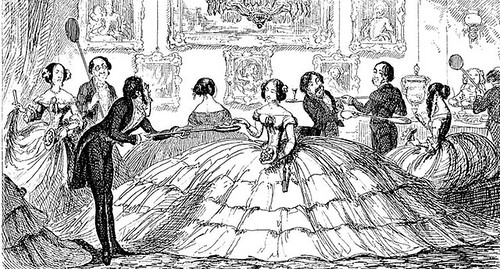
A satirical comic pokes fun at the ballooning crinolines
As the world grapples with the coronavirus outbreak, “social distancing” has become a buzzword of these strange times.
Fashion might not be the first thing that comes to mind when we think of isolation strategies. But as a historian who writes about the political and cultural meanings of clothing, I know that fashion can play an important role in the project of social distancing, whether the space created helps solve a health crisis or keep away pesky suitors.
Clothing has long served as a useful way to mitigate close contact and unnecessary exposure.
In the past, maintaining distance – especially between genders, classes and races – was an important aspect of social gatherings and public life. Social distancing didn't have anything to do with isolation or health; it was about etiquette and class. And fashion was the perfect tool.
Take the Victorian-era “crinoline.” This large, voluminous skirt, which became fashionable in the mid-19th century, was used to create a barrier between the genders in social settings.
While the origins of this trend can be traced to the 15th-century Spanish court, these voluminous skirts became a marker of class in the 18th century. Only those privileged enough to avoid household chores could wear them; you needed a house with enough space to be able to comfortably move from room to room, along with a servant to help you put it on. The bigger your skirt, the higher your status.
In the 1850s and 1860s, more middle-class women started wearing the crinoline as caged hoop skirts started being mass-produced. Soon, “Crinolinemania” swept the fashion world.
To read the complete article, see:
The fashionable history of social distancing
(https://theconversation.com/the-fashionable-history-of-social-distancing-134464)
NUMISMATIST EDITOR BARBARA GREGORY RETIRING
Well, it's the end of another era at the American Numismatic Association. ANA fixture Barbara Gregory, the long-long-time Editor-in-Chief of The Numismatist is retiring next month. We'll miss you! Here's the press release. -Editor
Gregory Closes ANA Chapter in April
After 38 years at the American Numismatic Association (ANA), The Numismatist Editor-in-Chief Barbara Gregory will retire next month. Her legend as the longest-running editor-in-chief at the ANA began in 1988. She also is the first female to hold the position. In mid-April, she passes the editorial responsibilities to current ANA Managing Editor Caleb Noel, who has worked for the numismatic publication since 2015.
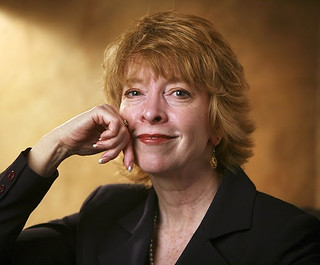 A native of Upstate New York, Gregory earned a
bachelor's degree in English from Alfred University in New York State's Southern Tier. Her passion for publishing and editing was first ignited in high school, where she
worked on the yearbook and newspaper staffs. Her passion continued through college, where she was a typesetter and editor of the college newspaper.
A native of Upstate New York, Gregory earned a
bachelor's degree in English from Alfred University in New York State's Southern Tier. Her passion for publishing and editing was first ignited in high school, where she
worked on the yearbook and newspaper staffs. Her passion continued through college, where she was a typesetter and editor of the college newspaper.
Before joining the ranks of the ANA as an editorial assistant in 1981, she worked previously as an assistant medical illustrator for the University of Rochester (New York) School of Medicine and Dentistry; a typesetter/layout artist for a Syracuse, New York, graphics firm and assistant editor of Aeronautics Digest, a quarterly journal produced by the United States Air Force Academy Department of Aeronautics in Colorado Springs, Colo.
Since Gregory has taken charge, the hobby publication has seen significant improvements throughout the years. Those changes include being the first hobby periodical to switch to desktop publishing, providing online access of the magazine to members (including a complete archive of all back issues), printing every edition in color and placing The Numismatist in Barnes and Noble across the nation. She also has been in charge of organizing and moderating the Legacy Series interviews with notable hobbyists at conventions since 2015.
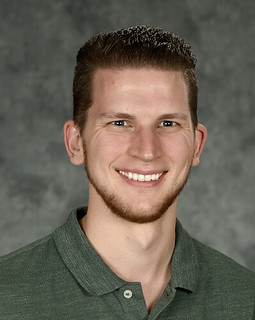 Gregory leaves the magazine in competent hands. ?Noel graduated
from the University of Colorado where he earned a degree in art history in 2015. His ANA journey began when he accepted an internship with the Edward C. Rochette Money Museum in
2013. Gregory invited Noel to work in the Publications Department in February 2015, and he was hired on full-time six months later.
Gregory leaves the magazine in competent hands. ?Noel graduated
from the University of Colorado where he earned a degree in art history in 2015. His ANA journey began when he accepted an internship with the Edward C. Rochette Money Museum in
2013. Gregory invited Noel to work in the Publications Department in February 2015, and he was hired on full-time six months later.
"I have been fortunate to work with many wonderful and talented editors in my 38 years at the ANA, but Caleb is the first to grasp all the ins and outs of magazine production," said Gregory. "He is a knowledgeable hobbyist, a brilliant wordsmith and grammarian; an accomplished photographer; an imaginative graphic designer; and a good-humored and diplomatic professional."
Although the publication is passing to new hands, The Numismatist will not change in quality or scholarship. However, the editorial department has been tasked with reducing expenditures, which will result in a smaller staff and slimmer magazine. Despite this, the department will continue to publish engaging and informative content to the standard members expect.
Wow - what a great run! Barbara is the only Numismatist editor most of us have ever known. Congratulations on a great career, and good luck in retirement! Best of luck as well to incoming editor Caleb Noel. -Editor
NGC CERTIFIES 10,000,000 SILVER EAGLES
This press release from NGC announces a new milestone in third-party grading. -Editor
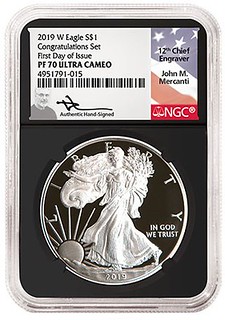
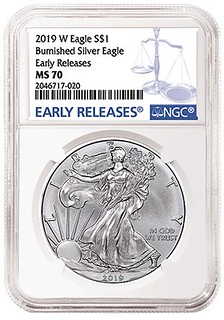
For years NGC has been at the forefront of American Silver Eagle certification and collecting.
Numismatic Guaranty Corporation (NGC) has announced that it has certified more than 10,000,000 American Silver Eagles. It is the first third-party grading service to reach this incredible milestone. The American Silver Eagle, the official silver bullion coin of the United States, is possibly the most widely collected coin in the world today. More than 530 million have been struck since 1986.
Collector interest in these coins has prompted the US Mint to strike versions in different finishes, including Mint State, Burnished Mint State, Specimen Enhanced Finish, Proof, Reverse Proof and Enhanced Reverse Proof. American Silver Eagles have also been struck at three of the four US Mint facilities currently in operation: Philadelphia, San Francisco and West Point. (None have been struck at Denver as of this date.)
For years NGC has been at the forefront of American Silver Eagle certification and collecting. It has developed and promoted a number of innovative encapsulation options including NGC Authentic Hand-Signed Labels. Among the people to sign labels for NGC is John Mercanti, the 12th US Mint Chief Engraver and designer of the reverse of the American Silver Eagle.
Other NGC programs for American Silver Eagles include its popular First Day of Issue, Early Releases and First Releases designations, NGC Color Cores and NGC Custom Core™ designs. These special encapsulation options enhance the presentation of coins and appeal to a wide range of collectors.
After NGC passed the 10,000,000 Silver Eagles certified mark some of the world's most respected and influential professional numismatists offered their congratulations.
Bill Gale, President of Asset Marketing Services, said: "I have collected and sold coins for over 40 years ?— the number of coins graded says it all! Collectors have trusted and found real value in NGC certification. As an Authorized Dealer for NGC, I'm proud to be able to provide high-quality NGC coins to collectors around the world!"
Lee Minshull, President of Minshull Trading, said: "This incredible achievement is a testament to NGC's superior overall product and market presence. Our customers are passionate about their Silver Eagles and demand an attractive presentation with their labels and holders. NGC continuously delivers that for us efficiently and at the highest quality. We use NGC almost exclusively for all the Silver Eagles we sell. They provide added value, protection and extraordinary service again and again – 10,000,000 times over."
Paul Minshull, Chief Operating Officer of Heritage Auctions, said: “The consistency and accuracy of NGC's grading, and its commitment to standing behind their products have helped attract legions of new collectors into a hobby that is now far safer, more transparent and more technologically advanced than ever before.”
Vincent Wade, President of Pinehurst Coins, added: “Collectors appreciate the value, security and beauty of the American Silver Eagle. All of these attributes are enhanced by NGC's attractive special labels and holders as well as NGC's comprehensive guarantee of authenticity and grade.”
American Silver Eagles is the most popular category of the NGC Registry, a free online platform where collectors register and display their NGC-certified coins. There are currently more the 5,800 American Silver Eagle sets in the NGC Registry, which can be found at NGCcoin.com/Registry.
"NGC's industry-leading certification services for American Silver Eagles and other coins have introduced countless new collectors to the hobby," says Mark Salzberg, NGC Chairman and Grading Finalizer. "We are honored and humbled to be trusted by so many collectors and dealers."
The NGC Census reports current population statistics for NGC-certified American Silver Eagles, helping collectors to understand relative rarity. For example, collectors can see that NGC has certified just 593 1995-W American Silver Eagles in PF 70 Ultra Cameo compared to 78,899 2016-W American Silver Eagles in PF 70 Ultra Cameo (as of August 13, 2019). The NGC Census is available for free at NGCcoin.com/Census.
NGC is the hobby's preferred third-party grading service for modern US coins by far. In addition to 10,000,000 American Silver Eagles, NGC has certified more than 1,500,000 American Gold Eagles, nearly 250,000 American Platinum Eagles, nearly 400,000 American Gold Buffaloes and nearly 1,000,000 modern US commemorative coins. For more information about NGC and its innovative holders and labels, visit NGCcoin.com.
To read the complete press release, see:
NGC Certifies 10,000,000 Silver Eagles
(https://www.ngccoin.com/news/article/7657/10-million-silver-eagles-graded/)
U.S. MINT AUTOMATES SLABBING WITH PARTNERSHIP
Meanwhile, PCGS ups the ante with new robotic technology and a direct partnership with the U.S. Mint. Here's the press release.
United States Mint Reveals Groundbreaking Industrial Automation Partnership

PCGS Grader Working in Tandem With Robot
The United States Mint (Mint) unveiled today the official rollout of a long-anticipated upgrade to its automation program. With the help of world-class experts at Japan's Yaskawa Corporation and the Progressional Coin Grading Service (PCGS), freshly-minted U.S. coins are whisked directly from the coin press to waiting graders, then within seconds hermetically sealed in labeled slabs for the worldwide numismatic market.
"We knew we had to do something to meet the increased demands of the market. We had to up our game to stay competitive" said the Mint's Chief Coining Engineer Douglas Smallerstaff.
Collector interest in third-party graded coins has swelled in recent years. making it hard for everyone involved to keep up. "Shipping to our grading facilities delayed time to market by days," said PCGS Vice President John Booker. "We decided to close the gap by setting up shop right at the source."
"It took many iterations to finally get everything right," Smallerstaff said. "At first the bots dropped every third coin on the floor." There was also a major problem with the literally "hot off the press" coins partially melting the slabs. The engineers added an air hose to blow on each one, like a birthday cake candle. "Sometimes it sounds like the Bronx Cheer, but we've learned to tune it out."
Booker notes that the problems didn't stop with the machines - "It was the people factor, too. Sometimes the line moved too fast. It looked like the VitaMeataVegamin episode from "I Love Lucy". We gave the graders multiple controls to direct the process. Grader Second Class Tyler Vannity told a reporter, "We have a joystick in our hand and click and hold it until a counter we see in the corner of the microscope hits the right grade. And we have a foot peddle to slow or speed up the assembly line. It's like a Peloton for coin geeks."
U.S. Mint Director David Ryder adds, "All 374 million 2020 Lincoln Cents have been slabbed by PCGS. None will be issued for circulation since nobody uses them anyway. We got 35 cents apiece, which paid for the cost of development and left $45 million for the U.S. Treasury. And a little something for the Mint marketing budget and 'coffee fund'. When travel restrictions lift we plan to book marketing trips to every major city in the world. And Las Vegas. Twice."

MUDLARKING AND METAL DETECTING FINDS
Anne Bentley of the Massachusetts Historical Society follows Liz Anderson on Twitter. Liz is a "mudlark", one who sifts through the mud of the Thames river at low tide looking for old artifacts. Anne shared one of Liz's recent numismatic finds. Thanks! -Editor
Anne writes:
"I'm always impressed by how she succinctly puts her finds into context for her viewers."
Tallow Chandler Token
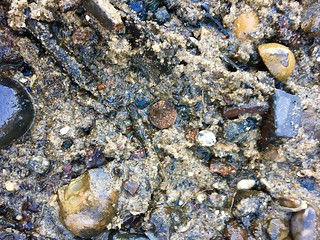
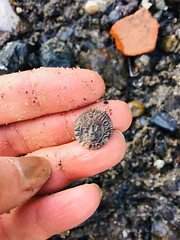
Peeking out from the Thames mud, a late 17th Century trader's token. Issued on behalf of Tallow Chandler Thomas Giltman of Gosswell Street, Clerkenwell. Tallow was made from the rendered fat of butchered animals, poured into a mould to make candles or soap.
To read the complete tweet, see:
https://twitter.com/liz_lizanderson/status/1237312972357283840?s=11
Anne also follows metal detectorist Nicola White. Here's one of her recent finds. -Editor
Antoninus Pius Denarius
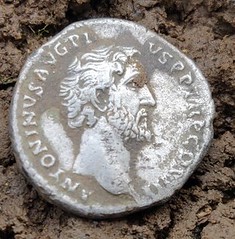
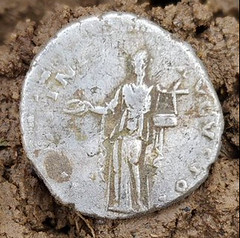
I recently found my first ever Roman coin whilst field detecting. Its an Antoninus Pius Denarius. Struck c 140-43 A.D. Rome Mint.Thank you to @TimothyMedhurst for the ID It was pretty exciting I have to confess! I will be taking it to my next @findsorguk visit #metaldetecting
Anne adds:
"Her excitement is very endearing, isn't it?"
To read the complete tweet, see:
https://twitter.com/tidelineart/status/1237397692340371456?s=11
To read the earlier E-Sylum article, see:
COINS FOUND MUDLARKING ON THE THAMES (https://www.coinbooks.org/v23/esylum_v23n06a13.html)
VOCABULARY TERM: KEY TAG MEDAL
Dick Johnson submitted this entry from his Encyclopedia of Coin and Medal Terminology. Thanks. I added images found on WorthPoint. -Editor
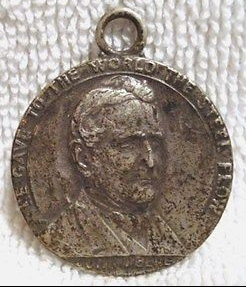
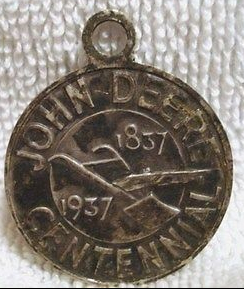
VINTAGE JOHN DEERE KEY TAG 1837 - 1937 CENTENNIAL MEDALLION
Key Tag Medal. The utilization of a medal to put on a ring of keys; they are always looped or holed. Because of their intense wear, key tag medals are struck in hard alloys; nickel-silver and copper nickel are well suited for this purpose. A large volume of any medal manufacturer's production is concerned with key tag medals so popular are they. Often they are made as a reduction of a larger medal as one of the more utilitarian purposes of medallic art. Sometimes these bear a serial number stamped on the back; they are issued with a card bearing the same number. When mailed back to the issuer they form a registry to identify the owner; when the keys are lost they can be returned to the owner through this registry.
Medal makers also have stock design key tag medals available to any one who wishes to order such. The Paris Mint, for example, has two dozen special designs available as key tags (in French, porte-clefs). These include designs from historical motifs, mythology, art scenes, zodiac medals, and of course, the ubiquitous Saint Christopher medal for travelers.
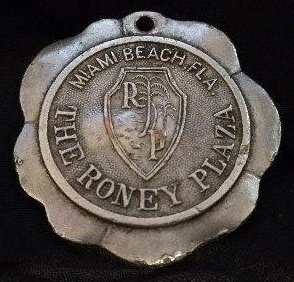
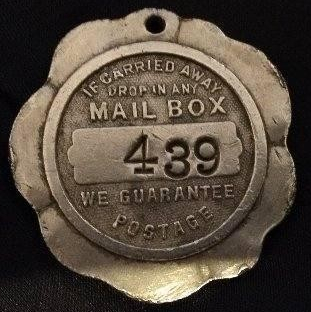
RONEY PLAZA HOTEL ~ MIAMI, BEACH FLA ROOM KEY TAG MEDAL
Looking for the meaning of a numismatic word, or the description of a term? Try the Newman Numismatic Portal's Numismatic Dictionary at: https://nnp.wustl.edu/library/dictionary
Or if you would like a printed copy of the complete Encyclopedia, it is available. There are 1,854 terms, on 678 pages, in The Encyclopedia of Coin and Medal Technology. Even running two a week would require more than 19 years to publish them all. If you would like an advance draft of this vital reference work it may be obtained from the author for your check of $50 sent postpaid. Dick Johnson, 139 Thompson Drive, Torrington, CT 06790.
DR. RICHARD GEORGE DOTY (1942-2013)
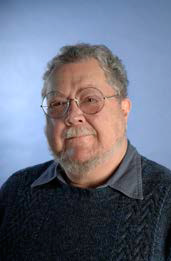 Dr. Richard George Doty (1942-2013), he was born
on January 11, 1942 the son of Mr. and Mrs. George B. Doty of Portland, Oregon. He graduated cum laude from Portland State University in 1964 and in 1967 received a doctorate
summa cum laude in Latin American studies from the University of Southern California with his dissertation entitled; "Manufacturing under Porfirio Diaz (USC, 1968)". He
taught United States and Latin American History as Assistant Professor at three institutions of higher learning : from 1967-1970 at Central College, Pella , Iowa; from 1970 -1972,
at York College, C.U.N.Y; from 1970-1971 at the University of Guam . From 1974 - 1986 he was curator at the American Numismatic Society, New York. 1986 he was appointed curator of
the National Numismatic Collection, in the Modern Coins and Money Department at the Smithsonian Institute, Washington D.C.
Dr. Richard George Doty (1942-2013), he was born
on January 11, 1942 the son of Mr. and Mrs. George B. Doty of Portland, Oregon. He graduated cum laude from Portland State University in 1964 and in 1967 received a doctorate
summa cum laude in Latin American studies from the University of Southern California with his dissertation entitled; "Manufacturing under Porfirio Diaz (USC, 1968)". He
taught United States and Latin American History as Assistant Professor at three institutions of higher learning : from 1967-1970 at Central College, Pella , Iowa; from 1970 -1972,
at York College, C.U.N.Y; from 1970-1971 at the University of Guam . From 1974 - 1986 he was curator at the American Numismatic Society, New York. 1986 he was appointed curator of
the National Numismatic Collection, in the Modern Coins and Money Department at the Smithsonian Institute, Washington D.C.
“He is also the recipient of a number of honors and awards, including a Fulbright Fellowship to the University of Madrid, Spain; Mexican Government Fellowship for study in Mexico City and Guadalajara; the Del Amo Foundation Fellowship for research in Spain, the Millennial Award Medal of the Royal Numismatic Society and the Lifetime Achievement Award from the American Numismatic Society.”
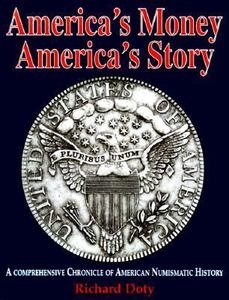
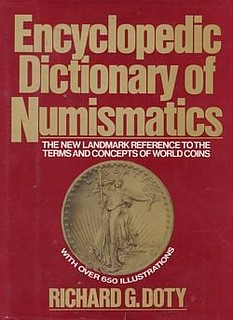
He is the author of fourteen important numismatic books including: co-authored with Eric P. Newman, Studies on Money in Early America (1976); Coins of the World (1976); Paper Money of the World (1977); The Macmillan Encyclopedic Dictionary of Numismatics (1982); America's Copper Coinage 1783-1857 (Proceedings of the Coinage of the Americas Conference, 1984); America's Silver Coinage 1794-1891 (Coinage of the Americas Conference (COAC), ANS, 1986); co-authored with Giovanni Gorini, La storia della moneta dall'antichita al giorno nostri (1988); co-authored and edited with John M. Kleeberg, The Token: America's Other Money (1995); Soho Mint and the Industrialization of Money (British Numismatic special publication, 1998); co-authored with Dave Bowers, A California Gold Rush: Featuring the Treasure from the S.S. Central America (2002); co-authored and edited with John M. Kleeberg, Money of the Caribbean (2006); co-authored/assisted and wrote the Foreword, for Jeff Garrett and Ron Guth, Encyclopedia of U. S. Gold Coins 1795-1933: Circulating, Proof, Commemorative, and Pattern Issues (2006); America's Money-America's Story (2008); Pictures From A Distant Country: Seeing America Through Old Paper Money (2013).
Richard Doty lived a full and rich personal life. He was married four times. His first wife was Joyce. His second wife was Carolyn Waite. His third wife was his co-worker Margaret Rose D'Ambrosio, the associate librarian at the American Numismatic Society, when he was curator of modern coins and paper money at the society. They were married November 10, 1984. Jean Somerville Kotkin, executive director of the American Ethical Union, performed the ceremony at the Society for Ethical Culture. Margaret kept her name Margaret Rose D'Ambrosio, professionally. She is a daughter of Margaret B. D'Ambrosio of Savannah, Georgia, and the late Joseph D'Ambrosio. She received a bachelor's degree and a master's degree in Russian literature from New York University and a master's in library science from Columbia University. They were divorced July 2009. His fourth wife was Cindy M. Roden. They were married in 2013. Dick was very fortunate to have the love and comfort of a devoted wife for his final year of life. Cindi remains behind and like all of us who knew Dick mourns his loss.
Dick left us too soon. I knew him in his role as curator of the National Numismatic Collection, and he joined us on a few occasions at dinners of Nummis Nova. His books are superb references. He is missed. -Editor
To read the complete article, see:
DOTY, RICHARD GEORGE
(https://sites.google.com/a/numismaticmall.com/www/numismaticmall-com/doty-richard-george)
HARVEY STACK'S NUMISMATIC FAMILY, PART 66
The latest article in Harvey Stack's blog series is about the firm's sales of 1975, including the standout collection of their unrelated “Dutch cousin” James A. Stack. Thanks, Harvey. -Editor
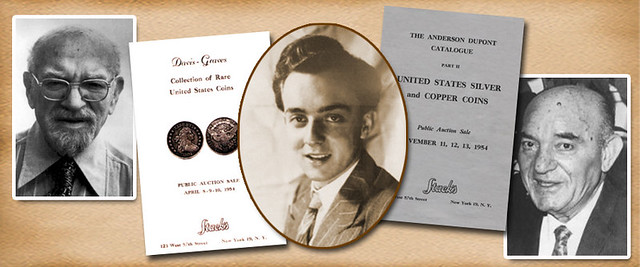
1975 was a great year for the continued growth of Stack's. In January 1975, I (Harvey G. Stack) was appointed to be a Governor of the United States Assay Commission for 1976 – the year of the Bicentennial of our nation. I was appointed by President Gerald Ford and it was a great honor to be a part of this, a process that had been established for nearly 200 years. It was felt that this might be the last Assay Commission to be convened as there was no longer precious metal in United States coinage.
This was not the only exciting thing that would be happening at Stack's in 1976. As noted we were involved with helping the Mint and the Smithsonian mount special Bicentennial displays. We also learned in 1975 that we had been chosen to present the Bicentennial year auction for the American Numismatic Association convention to be held in New York City. As the Big Apple was our home base, Stack's was well placed to conduct the auction. However, as always, there was negotiating to do in order to get the contract, as the ANA wanted $50,000 as the bid price, part of their plan to expand the ANA Headquarters in Colorado Springs. I believe this was more than ever requested before. My cousin Ben, known as a hard negotiator, was able to work out a deal that both sides could live with and we were awarded the contract.
In 1975 the coin market continued to grow, with new collectors attracted to the hobby who then became more sophisticated collectors, There were many advanced collectors building and completing collections. It was a good time for numismatics.
It was a history making year for Stack's as we had 10 important sales, with consignments from collectors, estates, universities and institutes. The year started with over 1,200 coins from the Essex Institute in Salem, Massachusetts, which had been chartered in 1821 to preserve and store valuable documents and colonial items from Essex County in that state. Because of limited space at the Institute, all the coins that had been contributed could not be adequately displayed. The Essex Institute decided to keep representative coinage of the early days of the country and sell the balance to raise funds for the expansion of its archives. Highlights of the sale were pieces that formed a comprehensive collection of United States coins from colonial issues until about 1900, in addition to a sampling of coinage from overseas that had been brought here from Europe by the new settlers.
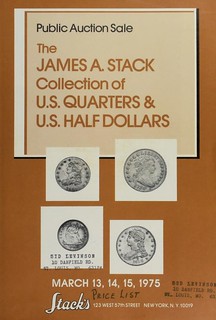 In March 1975 we presented the quarter and
half dollar collections built by James A. Stack. While Mr. Stack was unrelated to our family, my father, Morton, always called Jim his “Dutch cousin.” James A. Stack was a textile
broker in Wall Street, and after his wife passed away, he lived in the Roosevelt Hotel, just a few blocks from Stack's on 46th Street. The collection had been started by his
father, James Stack, and was continued by James A. Stack, becoming an extensive collection of United States gold, silver and copper coins. In 1975 James, Jr. decided to sell one
portion of it, an outstanding collection of quarters and half dollars, many of which carried important pedigrees. The quarters included 1796, 1804, 1827 Original and Restrike,
1842 Small Date Proof, and a virtually complete run of Proofs and Mint State quarters up to 1930. The half dollar collection, 1794 to 1947, was among the finest known and a
comprehensive offering by date and mint. Highlights included 1794, 1796 (both types), 1797, 1807 Proof, the rare 1838-O, 1846, 1849 and all from 1855, plus the rare Carson City
issues and all of the Barber and Walking Liberty series. There were 685 lots in this two day sale, and it remains an important pedigree to this day.
In March 1975 we presented the quarter and
half dollar collections built by James A. Stack. While Mr. Stack was unrelated to our family, my father, Morton, always called Jim his “Dutch cousin.” James A. Stack was a textile
broker in Wall Street, and after his wife passed away, he lived in the Roosevelt Hotel, just a few blocks from Stack's on 46th Street. The collection had been started by his
father, James Stack, and was continued by James A. Stack, becoming an extensive collection of United States gold, silver and copper coins. In 1975 James, Jr. decided to sell one
portion of it, an outstanding collection of quarters and half dollars, many of which carried important pedigrees. The quarters included 1796, 1804, 1827 Original and Restrike,
1842 Small Date Proof, and a virtually complete run of Proofs and Mint State quarters up to 1930. The half dollar collection, 1794 to 1947, was among the finest known and a
comprehensive offering by date and mint. Highlights included 1794, 1796 (both types), 1797, 1807 Proof, the rare 1838-O, 1846, 1849 and all from 1855, plus the rare Carson City
issues and all of the Barber and Walking Liberty series. There were 685 lots in this two day sale, and it remains an important pedigree to this day.
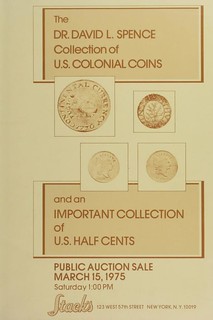 To make March 1975 even better, two weeks
later we offered the Dr. David A. Spence Collection of U.S. Colonial coins, along with a collection of U.S. half cents from a unnamed consignor. The Spence Collection, though just
over 100 lots, was one of the finest cabinets of colonial issues assembled in the mid 20th century and was a wonderful opportunity for colonial coin collectors. The half cent
auction that followed also featured enthusiastic bidding lot after lot! Many of those coins were pedigreed to our 1954 Anderson Dupont sale, where our unnamed consignor recognized
the quality of the pieces in that auction, and outbid those in attendance.
To make March 1975 even better, two weeks
later we offered the Dr. David A. Spence Collection of U.S. Colonial coins, along with a collection of U.S. half cents from a unnamed consignor. The Spence Collection, though just
over 100 lots, was one of the finest cabinets of colonial issues assembled in the mid 20th century and was a wonderful opportunity for colonial coin collectors. The half cent
auction that followed also featured enthusiastic bidding lot after lot! Many of those coins were pedigreed to our 1954 Anderson Dupont sale, where our unnamed consignor recognized
the quality of the pieces in that auction, and outbid those in attendance.
Two decades later, when he decided to sell his prize collection, he brought it back to Stack's to sell.
April brought two Stack's auctions, the first in early April featured a selection of collections, embracing United States gold, silver and copper, which gave less specialized collectors a chance to add to their collections. In the last week of April, we offered United States, European and Latin American gold.
Near the end of May 1975 we sold at auction consignments from Cornell University and Oglethorpe University. Like many other institutions, these colleges chose to deaccession coins they no longer displayed and use the funds to enhance their libraries or museums. Since these collections seemed to be complimentary we were able to merge them into a joint catalog featuring a wide variety of coins, a “something for everyone” sale.
In the later part of June we sold the Robert J. Kissner Collection of U.S. Large Cents, a specialized collection with many varieties and high quality coins from 1793 to 1814 and a comprehensive collection of early colonial coins, with a focus on the coins of New Jersey. It was a real collection for the specialized collector. Our “September Sale” of 1975 included several collections in all U.S. series just right for general collectors.
In October Stack's offered the outstanding U.S. coin collection formed by Dr. E.Y. Clark, a client of the firm since the mid 1940s who had attended many of our auctions during the 30 plus years he collected. He had a complete set of $3 gold (no 1870-S) mostly Proof and Mint State, a specialized collection of half dollars, highlighted by 1794, 1795, both 1796s, 1797, many Draped Bust pieces, the rare 1838-O and the 1853 No Arrows from the Cox Collection, plus many minor denomination series, mostly in Proof or Mint State.
Stack's concluded the auction year with the sale of the Dalton Family Collection of U.S. Coins, including small cents through silver dollars and gold coins of all denominations highlighted by an outstanding offering of gold coins from the branch mints at Charlotte, Dahlonega and New Orleans. This auction provided a huge opportunity to mintmark specialists who were looking to expand their collections of Southern gold. These 10 auctions, along with all the activity in our retail department, buying and selling, meant that 1975 was a time of great growth. And 1976 promised to be another fantastic year.
Dr. David Spence was a numismatic mentor of mine, a fellow member of The Sphinx Society in Pittsburgh. He in turn had been introduced to numismatics through another great member of that group, Dr. James O. Sloss. It was a pleasure to have known both gentlemen. -Editor
To read the complete article, see:
Harvey Stack Remembers: Growing up in a Numismatic Family, Part 66
(https://www.stacksbowers.com/News/Pages/Blogs.aspx?ArticleID=Harvey-Stack-Remembers-Part-66)
To read the earlier E-Sylum article, see:
HARVEY STACK'S NUMISMATIC FAMILY, PART 65 (https://www.coinbooks.org/v23/esylum_v23n11a16.html)
A NUMISMATIST'S VISIT TO NEW ORLEANS
Jeff Burke submitted this account of his recent visit to New Orleans and the numismatic sights and people he encountered there. Thanks! -Editor
Jeff Burke
Getting Our Bearings in a Fabled City
My wife Beth and I had a panoramic view of the Mississippi River from our 10th floor hotel room at the historic Hotel Monteleone in the heart of the French Quarter. It was so
thrilling to be in New Orleans for the first time! I had heard many wonderful childhood stories from my father about New Orleans and had always wanted to visit this special place.
However, we almost cancelled our trip because of growing coronavirus concerns. With one eye on the news and aware we might need to return to New Jersey any day, we decided to make
the most of the short time we did have in the Crescent City, March 8-13, 2020.
As I studied a hand-drawn map of the French Quarter (courtesy of our tour guide), I noticed the Old U.S. Mint on the far right side of the page. Today, the structure primarily serves as the New Orleans Jazz Museum. But in the 19th century it embodied
“...Andrew Jackson's long war with the Second Bank of the United States and paper currency. New Orleans was selected as a location for the manufacture of hard currency because it was the ‘emporium of the Great Valley' with gold and silver specie from Mexico flowing through its active markets.” (Winter, Douglas, et al. Gold Coins of the New Orleans Mint: 1839-1909, Zyrus Press, 2006, p.11).
Perhaps we would see shipwreck coins at the mint due to the history of hurricanes and lost ships in the Gulf of Mexico. I couldn't wait to see the mint in person!
The Old U.S. Mint
We walked around thirteen blocks through the French Quarter to the Old New Orleans Mint. A stop at an open air market vibrant with artisans making colorful jewelry and pottery
yielded a delicious muffuletta lunch with olives and melted cheese. It also got us completely turned around! Luckily, the Mississippi River helped us get our bearings. Despite the
temptations of Café du Monde and its beignets on the way, we finally located the imposing red brick structure of the mint.
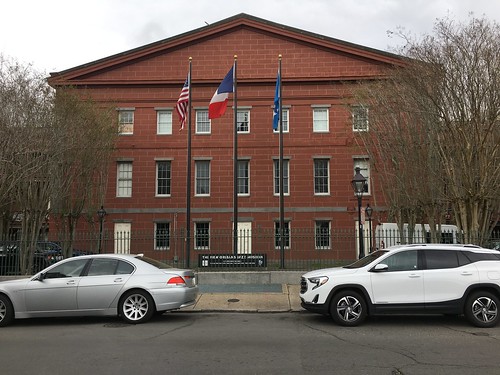
I tried to imagine what it was like to put in a long daily shift at the mint. What were the smells like in this facility during operations, which involved “treasury, melting and refining, assaying and coining”? (Winter, p. 12). Operating heavy machinery, with metal dust in the air combined with the subtropical climate of New Orleans, must have made for challenging working conditions.
As Beth and I checked our phones for COVID-19 updates, I recalled New Orleans' history of yellow fever epidemics. How had these impacted mint workers and coin production? And what would happen if we ended up in a modern-day quarantine in this city? Worries for both our fellow tourists and the many gracious New Orleanians who welcomed us to their hometown would linger throughout our time here.
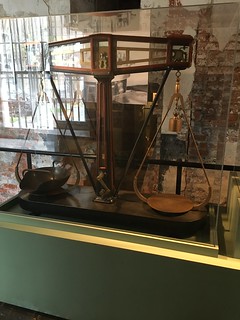
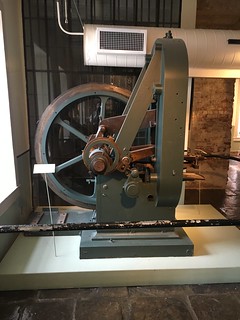
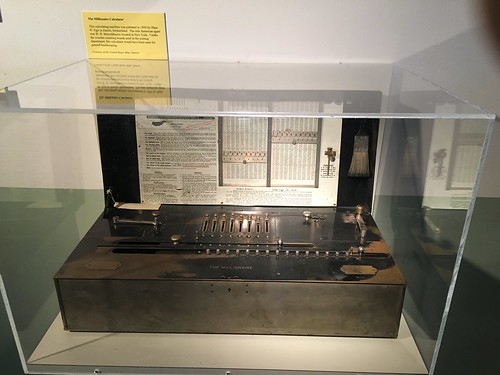
I was intrigued by the machinery at the mint. The adjusting process was used to prepare planchets for the coinage phase of the operations. Planchets were tested for proper weight before coining. Underweight planchets were returned to the melting department, and overweight planchets were designated for adjustment. From mint displays, I learned that between 1879 and the mint's closing in 1909, it was women who played the central role in the adjusting process. Women would file off excess metal until each planchet met the weight requirements. (Winter, pp. 14-15). Women played a prominent role in running the coining presses, as well.
Also of interest were a display of coins from the SS New York shipwreck. These coins were certified by NGC.
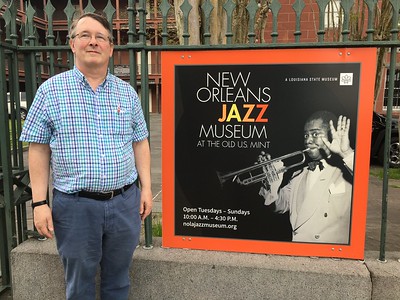
To view all of Jeff's Mint photos, see:
Jeff Burke's New Orleans Mint Visit March 2020
(https://www.flickr.com/photos/coinbooks/albums/72157713627009527)
James H. Cohen and President Ford
I also discovered some pirate treasure on Royal Street. I was meandering down the block and noticed a sign for antique weapons and rare coins. The next day, I decided to
investigate the shop and ended up learning about a modern day assayer. Not sure what to expect, I was pleasantly surprised to find a wide range of U.S. type coins, ancients, 16th
and 17th century European coins, an ANA 75th anniversary medal, obsolete paper money, shipwreck coins, Louisiana currency, Civil War tokens and currency, along with many other
numismatic items of interest.
I discovered a small showcase display dedicated to James H. Cohen, a distinguished numismatist who died at the age of 91 in 2017. Stephen and Jerald, his sons, kindly told me more information about their late father. Four generations of Cohens have owned and run this store!
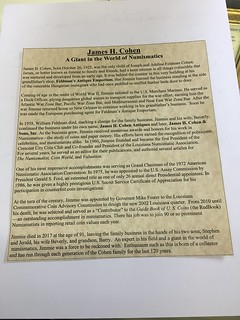
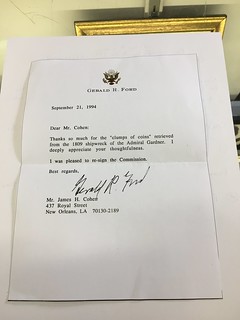
James was appointed to the United States Assay Commission by President Gerald Ford in 1975. Jerald told me a fascinating story about his father's commission letter, which was on display in a glass counter case. Over the years, the President's signature had begun to fade. In 1994, a customer came into the store and also noticed the fading ink. The stranger told James that he knew President Ford and could get the letter re-signed by him. James took a leap of faith and agreed to the proposal. Several weeks later, the re-signed letter arrived in the mail, along with a personal note from the former president!
Jerald told me that his father served as General Chairman of the ANA Convention in New Orleans in 1972. Jerald will be getting his 50-year ANA membership pin in a few years! As young boys, Stephen and Jerald worked in the shop with their father. Both boys developed an expert knowledge of numismatics from hands-on shop training from James and by traveling with their parents to trade shows in other parts of the country. (Gilkes, Paul “Veteran Numismatist Jimmie Cohen Dies in Louisiana,” Coin World, April 9, 2017). The Cohen family has had a long and storied numismatic history in the beautiful city of New Orleans.
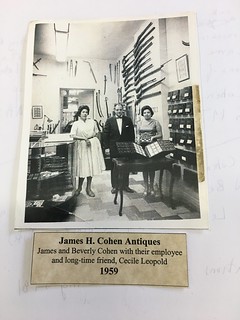
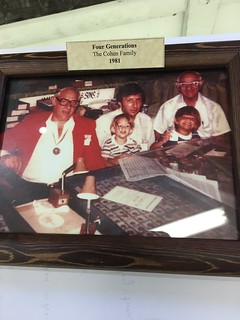
We achieved our dream of visiting New Orleans! I loved seeing the architectural styles in the French Quarter. Touring the mint gave me a deeper appreciation for the complex operations required to produce coins. Discovering the Cohen shop on Royal Street was a pleasant surprise! We also toured the Hurricane Katrina exhibit in the Presbytere Museum. Many people perished and property was destroyed when Katrina struck New Orleans on August 29, 2005. Yet, New Orleanians showed resolve, steadfastness and resiliency in the face of this tragedy and made a magnificent comeback. As we face the coronavirus pandemic, we can look to their courage in adversity as a model for our country.
Acknowledgements: My thanks go to Stephen and Jerald Cohen for sharing memories of their father with me. I am also grateful to Jerald for pulling some family pictures and other documents from a display case to share with me. The Cohen brothers read through a draft of this piece for the sake of accuracy.
To visit the James H. Cohen & Sons, Inc web site, see:
https://cohenantiques.com/
MORE SELECTIONS FROM DAVISSON'S AUCTION 39
Here are some more lots that caught my eye in the Davisson's auction closing April 1, 2020 -Editor
Lot 45: Ptolemy I Soter Tetradrachm
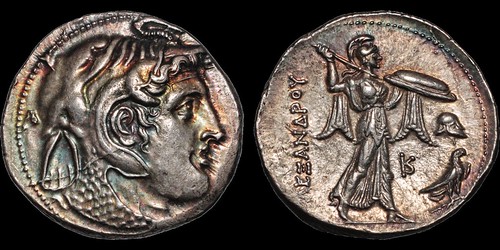
PTOLEMAIC KINGS OF EGYPT. Ptolemy I Soter. As satrap (323-305 B.C.) or king (305-282 B.C.) AR tetradrachm. 15.76 gm. 29 mm. In the name of Alexander III 'the Great' of Macedon. First reduced standard. Alexandria mint. Struck circa 306-300 B.C. Horned head of the deified Alexander right, wearing elephant skin headdress; small ? (artist's signature) in scales on aegis, additional small ? (die break?) behind head / Athena Alkidemos advancing right, holding shield and spear; Corinthian helmet, monogram, and eagle standing on thunderbolt to right, ?????????? to left. CPE 70. Svoronos 164. Zervos Issue 29. Good Extremely Fine; well centered and sharply struck with beautiful old iridescent tone; hairline die break from ear to back of neck, and behind crown of head on obverse; hairline die break on reverse to right of shield. Exceptional quality.
Ex Davissons Auction 24 (8 December 2005) lot 148 ($2200)
Ex CNG Auction 43 (24 September 1997) lot 880 ($1015).
Beautiful coin, well struck and centered, and great toning to boot. -Editor
To read the complete lot description, see:
PTOLEMAIC KINGS OF EGYPT. Ptolemy I Soter. (https://davcoin.com/lot/printed-auction-39-lot-45)
Lot 54: ROMAN REPUBLICAN. Lucius Caesius Denarius.
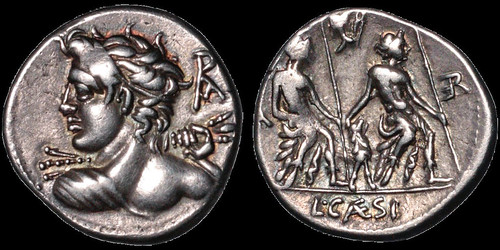
ROMAN REPUBLICAN. Lucius Caesius. 112-111 B.C. AR denarius. 3.89 gm. 20 mm. Rome mint. Youthful draped bust of Vejovis left, seen from behind, hurling thunderbolt; ROMA monogram to right / Two Lares seated right, each holding a staff, dog standing right between them; [LA] (ligate) to left, RE (retrograde and ligate) to right, head of Vulcan and tongs above, L CÆSI in exergue. Crawford 298/1. Sydenham 564. RSC Caesia 1. Good Very Fine; beautiful old iridescent tone over minty surfaces; some areas of flatness; overall a handsome coin of wonderful style.
From RSC: "Vejovis was a Latin divinity of a destructive nature. The 'Lares praestites' were the protecting spirits of the city of Rome and may be identified with Romulus and Remus. The head of Vulcan and the tongs relate to the office of moneyer."
It's unusual to see a figure pictured from behind on a coin. Great muscles! -Editor
To read the complete lot description, see:
ROMAN REPUBLICAN. Lucius Caesius. (https://davcoin.com/lot/printed-auction-39-lot-54)
Lot 90: ANGLO-SAXON. Secondary Sceatta
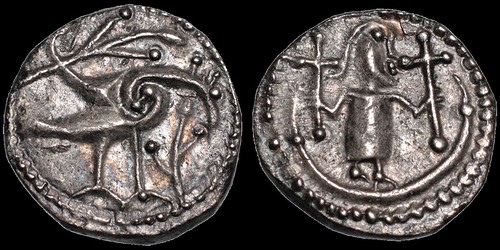
ANGLO-SAXON. Secondary Sceatta. Circa 710-760. AR sceat. 1.06 gm. 12 mm. Series U. Type 23B. A fantastic bird right, branch above, plant on ground in front / Human figure standing facing, head right, holding cross in each hand. S. 816. N. 83. Metcalf 449-50. Choice Extremely Fine; exceptional example; rare and rare thus.
A truly weird bird and bizarre-looking horse-faced human. Neat coin. -Editor
To read the complete lot description, see:
ANGLO-SAXON. Secondary Sceatta. (https://davcoin.com/lot/printed-auction-39-lot-90)
Lot 246: 1797 Skidmore Churches and Gates Token
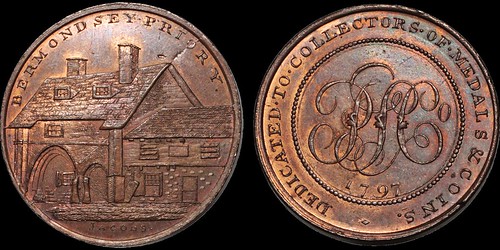
Middlesex 667. Skidmore Churches and Gates. Surrey, Bermondsey. Copper halfpenny. 11.62 gm. 29 mm. A large home; BERMONDSEY PRIORY around above, Jacobs in smaller letters below / PSCo cypher; DEDICATED TO COLLECTORS OF MEDALS & COINS 1797 (Rev 2). Uncirculated; lightly toned over fresh surfaces; substantial original color present.
The Mike Sussman Collection of British Trade Tokens.
There are many, many great tokens in this collection. Where to start? Here's a typical example. Great piece. -Editor
To read the complete lot description, see:
Middlesex 667. Skidmore Churches and Gates. (https://davcoin.com/lot/printed-auction-39-lot-246)
ARCHIVES INTERNATIONAL SALE #58 SELECTIONS
Here some items that caught my eye in the upcoming Archives International sale. -Editor
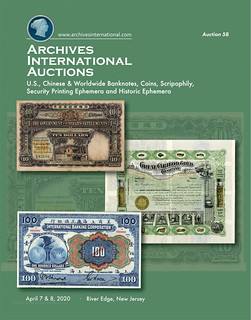
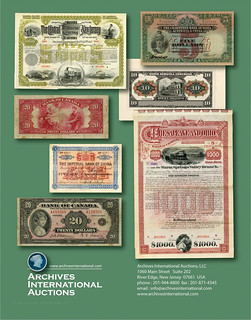
Lot 126: 1905 International Banking Corporation $100 Note
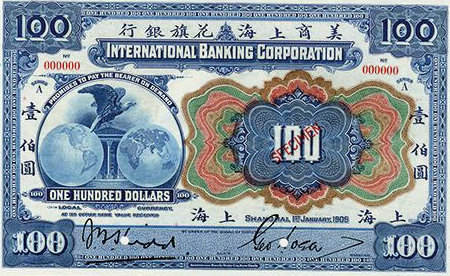
Shanghai, China, 1905. $100, P-S422s, S/M #M10-5. Blue face and back. Screaming eagle on top of 2 globes at left and in middle on back, 2 printed signatures. Specimen banknote. Red specimen overprint, 00000 serial numbers and POC's. PMG graded Gem uncirculated 65 EPQ condition. A trophy for the advanced collector. ABNC.
Pretty multicolor note. I like blue. But there's much more to like for the serious banknote collector. Great piece. -Editor
To read the complete lot description, see:
International Banking Corporation, 1905 Issue $100
Specimen Banknote. (https://auction.archivesinternational.com/International-Banking-Corporation-1905-Issue-100-Specimen-Banknote_i36522392)
Lot 181: 1784 Copenhagen Rigsdaler Note
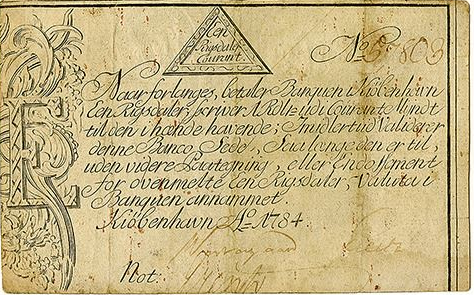
Kobenhaven, Denmark. 1784. 1 Rigsdaler Courant, P-A24c, Issued banknote, S/N 57803, PMG graded Very Fine 30. Scarce note in any condition. Only 3 graded with this example by far the highest graded.
Interesting rare item. -Editor
To read the complete lot description, see:
Denmark, Copenhagen Notes, 1784 Issued Banknote.
(https://auction.archivesinternational.com/Denmark-Copenhagen-Notes-1784-Issued-Banknote_i36522447)
Lot 255: 1917 Strasburg POW Camp Notes
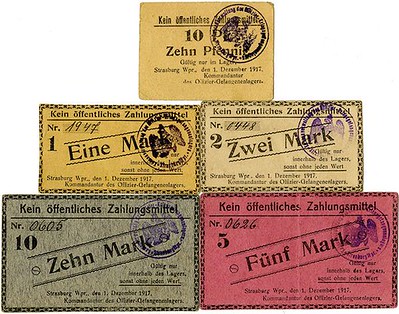
Germany, Strasburg Wpr. Lot of 5, includes 10 Pfennig, 1, 2, 5, and 10 Mark, 1917. Uniface. Round validation stamps on front. Choice VF or better.
P.O.W. notes are an interesting area of paper money. -Editor
To read the complete lot description, see:
Germany. Strasburg Wpr. POW Camp. 1917. Quintet of
Notgeld. (https://auction.archivesinternational.com/Germany-Strasburg-Wpr-POW-Camp-1917-Quintet-of-Notgeld_i36522521)
Lot 591: Bradbury, Wilkinson & Co. Test Note
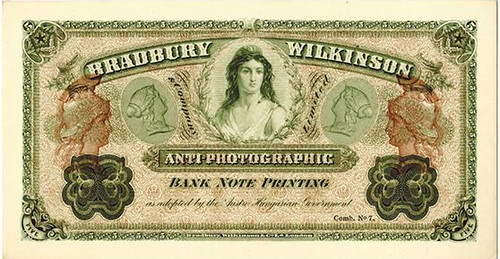
Great Britain, uniface intaglio-printed, "anti-photographic" test note, denomination of "5 Units", five stylized heads facing left, right, and front. BWC. PMG graded Choice Uncirculated 64.
Attractive, colorful piece. -Editor
To read the complete lot description, see:
Bradbury, Wilkinson & Co. ND (1860s-70s). Test Note.
(https://auction.archivesinternational.com/Bradbury-Wilkinson-Co-ND-1860s-70s-Test-Note_i36522857)
Lot 609: Excelsior Bank Note Company Vignette Advertising Sheet
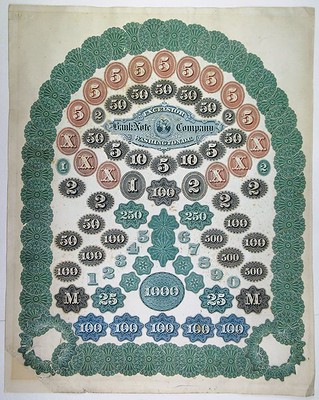
Washington, D.C., 14 x 17.5 inches, Multiple vignettes, counters and cycloid engravings glued to a thin card. Possibly it was meant to be used in a presentation or was framed in their office. Overall XF condition. Colorful and unique. Excelsior had offices in Washington, DC and New York, NY and was formed sometime prior to 1 January 1876 by John G. Wellstood.
Great display item. -Editor
To read the complete lot description, see:
Excelsior Bank Note Company, ND (ca.1878-1880)
Vignette Advertising Sheet. (https://auction.archivesinternational.com/Excelsior-Bank-Note-Company-ND-ca-1878-1880-Vignette-Advertising-Sheet_i36522875)

THE UNION LEAGUE MEDAL OF HONOR
Students of U.S. medals will appreciate an article by Frank Kovacs in the latest volume of the American Journal of Numismatics. At my request editor David Yoon kindly forwarded this excerpt from "The Medal of Honor of the Union League of Philadelphia" in AJN 31. Thanks! -Editor
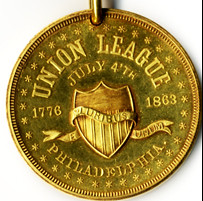
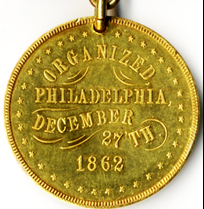
Images adapted from the Detroit Public Library
The author presents a catalogue of over seventy examples of the Union League Medal of Honor and arranges them in chronological order through the use of die sequencing and datable provenanced examples. A distinction is made between those medals awarded during the Civil War years and those after; and for the use of buckles on the ribbons of some medals but not on others.
In the early stages of the American Civil War (1861–65) a number of Philadelphia's prominent citizens whose sympathies were pro-Union and anti-slavery first met as the Union Club on November 15, 1862. Shortly thereafter (December 27, 1862) the Union League of Philadelphia was formally established. The League's primary purpose was the preservation of the Union at all costs. To this end the Union League raised money for its numerous pro-Union publications, and provided the model for the many Union League organizations which quickly formed throughout the north. Members of Philadelphia's Union League soon established a Supervisory Committee for the Enlistment of Colored Troops which was responsible for the enlistment and equipping of five black regiments and the funding of a school for the training of their officers. The Union League also provided substantial funds for the reinforcement of Philadelphia's emergency defenses in anticipation of a Confederate attack.
In the midst of this chaos, the Union League created a medal to honor those individuals whose efforts on behalf of the Union cause were deemed outstanding. On August 16, 1863, the first of these medals was given in gold to President Abraham Lincoln, followed by examples in silver to members of Lincoln's cabinet. Additional medals were given to military and naval commanders, and to civilians, domestic and foreign. The Union League's roll indicates one gold and forty-eight silver in 1863; one gold and eleven silver in 1864, one gold and five silver in 1865, and one gold and one silver in 1866. The totals for the Civil War years are four gold and sixty-five silver medals. Post-Civil War issues are sporadic with nine medals in gold and none in silver for the years 1868–1954. It will become apparent below that the roll of recipients is incomplete.
Purpose
The purpose of this study is twofold: first, to identify those medals which were given in the context of the Civil War, as distinguished from those given afterwards and, second,
to determine the significance, if any, of the different reverse designs, and types of suspension.
For a Union League medal at the Detroit Public Library, see:
Union League medal
(https://digitalcollections.detroitpubliclibrary.org/islandora/object/islandora%3A238052)
SECURITY MARBLING ON FINANCIAL INSTRUMENTS
Students of U.S. colonial currency will appreciate an article by Jake Benson in the latest volume of the American Journal of Numismatics. David Yoon also forwarded this excerpt from "Curious Colors of Currency: Security Marbling on Financial Instruments During the Long Eighteenth Century" in AJN 31. Thanks! -Editor
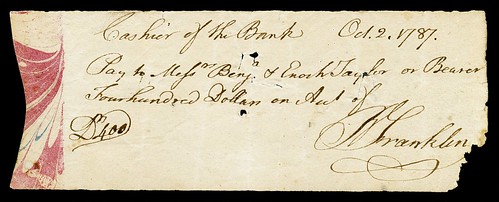
National Numismatic Collection NNC 1979.1263.01594
The twenty-dollar bills authorized by the Continental Congress and dated May 10, 1775, feature a hand-marbled margin applied as a polychrome security device. The association of Benjamin Franklin with these notes has led scholars to attribute the concept of security marbling to his genius. This article shows that security marbling was first adopted by the Bank of England in 1695. It is further argued that both fractional reserve banking and the issuance of paper currency were intimately intertwined with the advent of paper marbling in England during the mid-seventeenth century. Evidence is presented to show that a Persian artist and émigré to India, Muhammad Tahir, was the true innovator behind the combed and chevron marbled patterns that were later applied to financial instruments.
Introduction and Background
Many numismatic historians and collectors are familiar with an emission of 10,800 twenty-dollar bills that the Continental Congress authorized on July 22–23, 1775, then issued
with the back-date of May 10, when the Second Continental Congress convened in Philadelphia. They were printed on sheets bearing a curious, hand-marbled polychrome margin along
the left side of the obverse as a security device. The marbled papers are thought to have been procured by Benjamin Franklin, who also designed the emblem on the obverse depicting
the wind blowing over waves surmounted by a Latin motto VI CONCITATÆ (driven by force; Pl. 37, 1). Avid interest among numismatic collectors in this specific emission has resulted
in five-figure sales at auction in recent years, a considerable sum for historical paper currency. Prior writers have attributed the concept of security marbling to Franklin's
genius; however, it will be shown that this practice was already well-established in London prior to, during, and well after the periods that he resided there.
Significant evidence proves that the formative years of fractional reserve banking and issuance of paper currency were intimately intertwined with the advent of paper marbling in England. Together with new research on the origins and evolution of marbling in the Islamic world, and its subsequent spread to Europe, this essay provides an overview of security marbling throughout the “long eighteenth century” (ca. 1695–1815), until it was ultimately superseded by mechanized security printing.
VIDEO: JAPANESE BANKNOTE SECURITY FEATURES
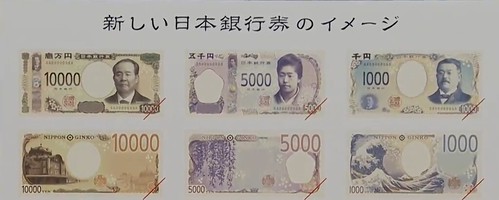
Chris Neuzil writes:
"I came across a half hour program produced by NHK, Japan's national TV network, on Japanese banknotes. It's for a lay audience but has surprising details about security features, the process of going from artwork to printing plates, why Japanese currency is among the world's least counterfeited, Japanese traditions of gifting cash, and why Japanese still conduct about 80% of transactions in cash. There are some nice views of Japans's currency printing facility operations too."
Great video, nicely done. Thanks. -Editor
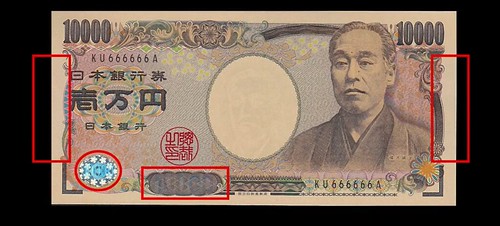
Banknotes
Japanology Plus 28m 00s Broadcast on November 5, 2019 / Available until March 31, 2022
Japan's paper money incorporates some of the most advanced security features in the world, including pin-sharp watermarks, and microscopic text. This time on Japanology Plus, our theme is banknotes. Researcher Takashi Uemura, a former employee of what is now known as the National Printing Bureau, tells us why cash is still the payment method of choice for most Japanese shoppers. And in Plus One, Matt Alt learns about the elaborate envelopes that are used to gift money on special occasions.
Chris adds:
"What supposedly makes Japanese currency so hard to counterfeit? They say it's the watermark and compare it to watermarks on US currency. Ouch."
To read the complete article, see:
Banknotes Japanology Plus (https://www3.nhk.or.jp/nhkworld/en/ondemand/video/2032197/)
LOOSE CHANGE: MARCH 29, 2020
Here are some additional items in the media this week that may be of interest. -Editor
Missing 1913 Liberty Nickels Located?
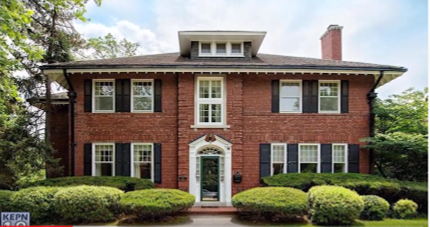
Eric P. Newman's Former Residence, Cecil Avenue, St. Louis, MO
I literally just saw this one as I was getting ready to publish tonight's newsletter. This will rewrite some numismatic history and will likely result in a legal battle as big as that over the 1933 double eagles or the S.S. Central America treasure. Something here for coin and National Bank Note collectors alike. Watch the numismatic media for more coverage this week.
The original 1913 Liberty Nickel case had eight slots, with five of the slots holding the five known 1913 Liberty Nickels. People have always wondered why the other slots were populated with three random Buffalo nickels. Looks like two more 1913 Liberty nickels have been found. Wow! Check out tonight's 10 o'clock news coverage from a St. Louis TV station. -Editor
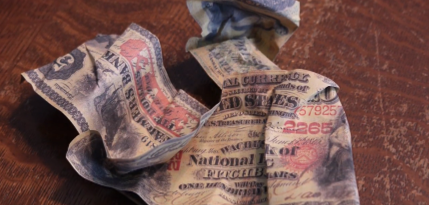
To watch the complete video report, see:
Wooden Leg Sets St. Louis Legal Community on Fire
(https://www.youtube.com/watch?v=rUDSACJzzOE&feature=youtu.be)
Ursula Kampmann of CoinsWeekly published an article about the late Swiss numismatist and author Edwin Tobler. -Editor
To read the complete article, see:
Edwin Tobler (1922-2020) (https://coinsweekly.com/edwin-tobler-1922-2020/)
A Digital ‘Treasury Dollar Bill'
Here's a Forbes piece on planning for a U.S. digital dollar. -Editor
On March 23rd House Democrats did something I and many others have been advocating for some time – draft plans to legislate into existence a digital dollar, along with a system of digital wallets.
We'll call it a Treasury Dollar Bill (TDB). It is effectively a one-dollar ‘perpetual,' a.k.a. ‘consol,' much like the Federal Reserve notes we call ‘dollar bills.' Treasury will directly convey Congressionally determined ‘amounts' of these Treasury Dollar Bills, which we'll call ‘Starter Deposits,' to holders of Treasury Direct Accounts, which can be digitized into digital wallets as described below.
To read the complete article, see:
How To Keep The
Digital Dollar Democratic: A ‘Treasury Dollar Bill' / ‘Treasury Direct' Plan
(https://www.forbes.com/sites/rhockett/2020/03/24/how-to-keep-the-digital-dollar-democratic-a-treasury-dollar-bill--treasury-direct-plan/#7219fc4d37c8)
Emperor Hadrian's Travel Series Coins
Here's another nice CoinWeek Ancient Coin Series article by Mike Markowitz. -Editor
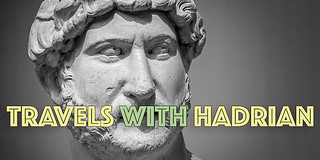 IN THE ANCIENT WORLD, TRAVEL was
hazardous and uncomfortable, even for the elite.
IN THE ANCIENT WORLD, TRAVEL was
hazardous and uncomfortable, even for the elite.
Yet remarkably, the Roman emperor Hadrian spent half of his 21-year reign on the road, visiting almost every province of the vast empire. The mint celebrated these grand tours with extensive coinage in gold, silver and bronze, known to numismatists as the “Travel Series”.
To read the complete article, see:
CoinWeek Ancient Coin Series: Travels With Hadrian
(https://coinweek.com/ancient-coins/coinweek-ancient-coin-series-travels-with-hadrian/)
PULL TAB ARCHEOLOGY
In the things-other-people-collect department is this Dutch collector of pull tabs - "those humble little things that help you crack open anything from tins of fish to cans of beer". From Atlas Obscura. -Editor
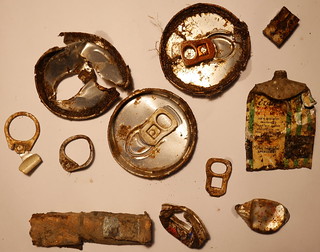 The whole concept of Wijnen's project, which
he calls Pull Tab Archeology, started out as a joke. By trade, he's a contemporary archaeologist, studying the physical evidence that humans have left behind over the last several
decades. Instead of plumbing the ground for items that have been there for centuries, or even millennia, he focuses on things that have only been around since the 20th or 21st
centuries.
The whole concept of Wijnen's project, which
he calls Pull Tab Archeology, started out as a joke. By trade, he's a contemporary archaeologist, studying the physical evidence that humans have left behind over the last several
decades. Instead of plumbing the ground for items that have been there for centuries, or even millennia, he focuses on things that have only been around since the 20th or 21st
centuries.
In the Netherlands, where Wijnen lives and works, many archaeologists had long swooned only over things that are well and truly old, he says, and hadn't been especially keen on newer finds. Until fairly recently, he adds, anything more recent than the medieval period wasn't particularly alluring to old-school archaeologists. But in the past few decades, archaeologists began doubling down on their efforts to excavate World War II–era sites. “It was completely a new duck in the pond,” says Wijnen.
About 10 years ago he was excavating some World War II–era trenches around the Grebbeberg—a hill in Rhenen that was the site of a bloody defense against German forces—and found that the top layer of soil was littered with pull tabs. Over the next few years, he started facetiously kicking around the notion of collecting as many as he could, and seeing how they stacked up against one another.
As he did, he realized that he had hit on a solid idea. “I started to realize, ‘Whoa, this is not just a joke,'” he says. “There's much more to learn here than I would have expected.”
Most people have probably handled a pull tab to crack open a can of soda or soup, and would recognize the object without having looked particularly closely at it. The metal gizmos all look somewhat similar—a bit like a freshly filed fingernail—but they have scores of subtle differences that point to the time and place they were manufactured.
Canned drinks really took off after the second World War, and over the next few decades, punch-top cans gave way to tabbed ones. Some pull tabs are single loops, like little rings that someone would stick a finger through; others, known as “Sta-Tabs,” were designed to push a tear strip into the can to create an opening, while the tab remained on the can so it didn't wind up on the ground. Different tabs have different perforations, different angles, and slews of other other variations.
Wijnen is keen to get a handle on how different manufacturers' styles have varied across time and place. “Two types that I know of—very early ones, called zip-tops and U-tabs—have never been produced in Europe, as far as I know,” he says.
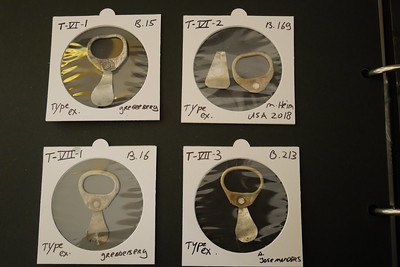
Wijnen's reference types are meticulously organized.
Looking for something so mundane can turn out to be a little wondrous. Pull tabs are ubiquitous, but also easy to overlook—they blend into the background of the various bits of trash, debris, leaf litter freckling the ground. “It's a silly thing that no one looks at normally,” Wijnen says. “But when you do, you start seeing them everywhere.”
Wijnen says that before 2018, he was a bit of a lone wolf, prowling for tabs on his own, with occasional help from colleagues who would pass their finds on to him. Then, “in 2018, I said, ‘Let's do it big time, and do it globally, and ask everyone in the world to send me the pull tabs they can find.” So far, he has amassed more than 3,060 tabs.
“Suddenly I get an envelope in my mailbox from Taiwan or Shanghai or Australia or Texas,” he says, “and I never would have found them myself because I don't have time or money to travel.”
Ideally, these donated tabs come with beautifully precise location information, down to an address where they were collected. That allows Wijnen to map them all.
To read the complete article, see:
The Archaeology of Those Weird Metal Things That Open Your Soda Can
(https://www.atlasobscura.com/articles/archaeology-of-cans)
COLLECTING BANANA LABELS
Here's a great CNN article also in the things-other-people-collect department: banana labels. Don't laugh - read the article, and you'll find many parallels in interest, sensibilities and determination with those of us in the numismatic world. This is just an excerpt - see the complete article online. -Editor
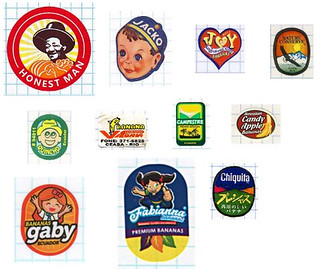 If you see a 70-year-old woman digging through a
trash can for discarded banana peels in Florida, you may have spotted one of the world's most unique collectors.
If you see a 70-year-old woman digging through a
trash can for discarded banana peels in Florida, you may have spotted one of the world's most unique collectors.
Becky Martz, of Orlando, has spent the past 29 years fastidiously collecting and cataloging more than 21,000 banana labels from around the world.
Martz's hobby has led her to Germany, Costa Rica and Ecuador where she's met with fellow collectors and picked up random banana labels, she told CNN via email.
"What makes them special to me is that they are ephemeral. They are meant to be thrown away," Martz told CNN. "For some reason, that makes them even more precious to me. I have rescued many labels from the trash or a banana peel on the ground. I feel sad when I see someone has thrown a peel away with the label still on it, so I rescue it."
Martz first noticed how unique banana labels were in 1991. She was restocking her fruit bowl when she saw how the old Dole banana labels were from Guatemala and the new ones were from Honduras.
"I wondered how many different countries I could find on those Dole labels," Martz said. "That is when I first started paying attention to them and noticing differences. I like that they are free. I like that they are designed to capture your attention. I like that they send messages. I like that they are tiny works of art."
By Christmas of that year, Martz's curiosity grew after Chiquita had put a label on their bananas that said "The Perfect Stocking Stuffer." This was the first label she kept.
That one label quickly grew to 17, thus necessitating the need for a small photo album to store them.
A few years later, one of Martz's sons discovered that his mom was part of a small, yet vibrant, banana label-collecting community that spanned the globe. While searching around the nascent internet in the mid-1990s, Martz's son, Carl, found a handful of rudimentary websites belonging to other banana label enthusiasts from around the world.
Martz has since attended banana label collector meetings around the world, including one of the largest gatherings in Costa Rica in 2008.
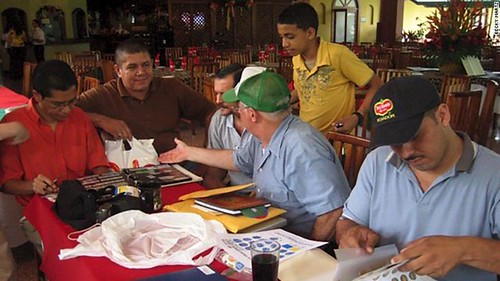
Banana label collectors meeting in Costa Rica
It is unclear, exactly, how many collectors there are around the world. Martz estimates that there might be 25 in the US, roughly 50 in Asia and 200 in Central and South America.
"Many of the collectors work in the banana business but when I was in Costa Rica it seemed like every other person from the hotel maids to store owners had a collection. Most of them had no interest in trading, just in collecting from bananas themselves," she said.
"I have made many good friends through our shared love of banana labels. In fact, my husband says that I now collect banana friends," Martz said. "My best 'banana friend' is a guy in Slovenia. He has visited us a number of times. A few years ago, we went to his wedding in Ljubljana. They named one of their children after me."
Despite the lack of meetups, Martz's passion for collecting hasn't diminished. She still searches for a prized two-label set.
"In 1980, Chiquita printed some labels with the mascot of the summer Olympics called Misha," Martz said. "The US boycotted the summer Olympics due to the Soviet-Afghan War, so the labels were never used. A few escaped destruction. I don't have it, yet, but I am ever hopeful."
To read the complete article, see:
How one Florida woman amassed a collection of more than 21,000 banana labels
(https://www.cnn.com/2020/02/22/us/banana-label-collector-becky-martz-trnd/index.html)
FEATURED WEB SITE: MALTA NUMISMATIC SOCIETY
This week's Featured Web Site is the Malta Numismatic Society.The Malta Numismatic Society is a non profit organisation founded in 2020 and includes as its members numismatic academics such as John Gatt and Emanuel Azzopardi.
The scope of the society is to encourage and promote the study and collection of numismatics and exonumia, namely but not limited to coins from antiquity until the present day, as well as banknotes, tokens, jetons, medals, seals, dies and weights related to the Maltese Islands throughout its history.
The society will strive to publish articles and papers, to promote study and discussion, organise cultural events and activities, thus providing a focal point for numismatics, scholars and amateur collectors in a pleasant environment.
The society will promote fair trade and discourage fraudulent practices such as dealing in forgeries.
The society will endeavour to stock a library of numismatic books, catalogues and publications to be made available to its members. The society will liaise with foreign numismatic societies as well as curators and museums of related numismatic collections worldwide.

https://www.mns.mt/

